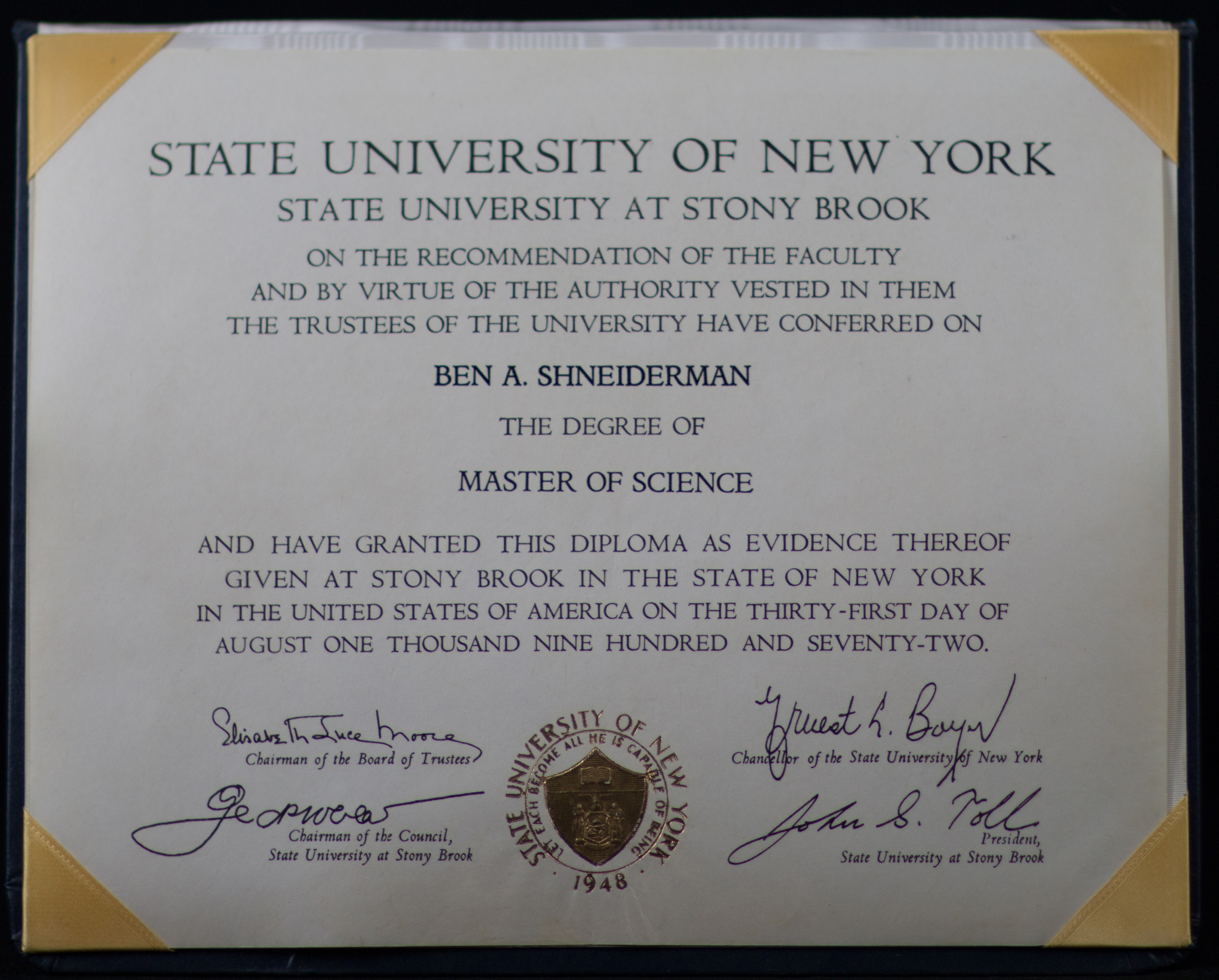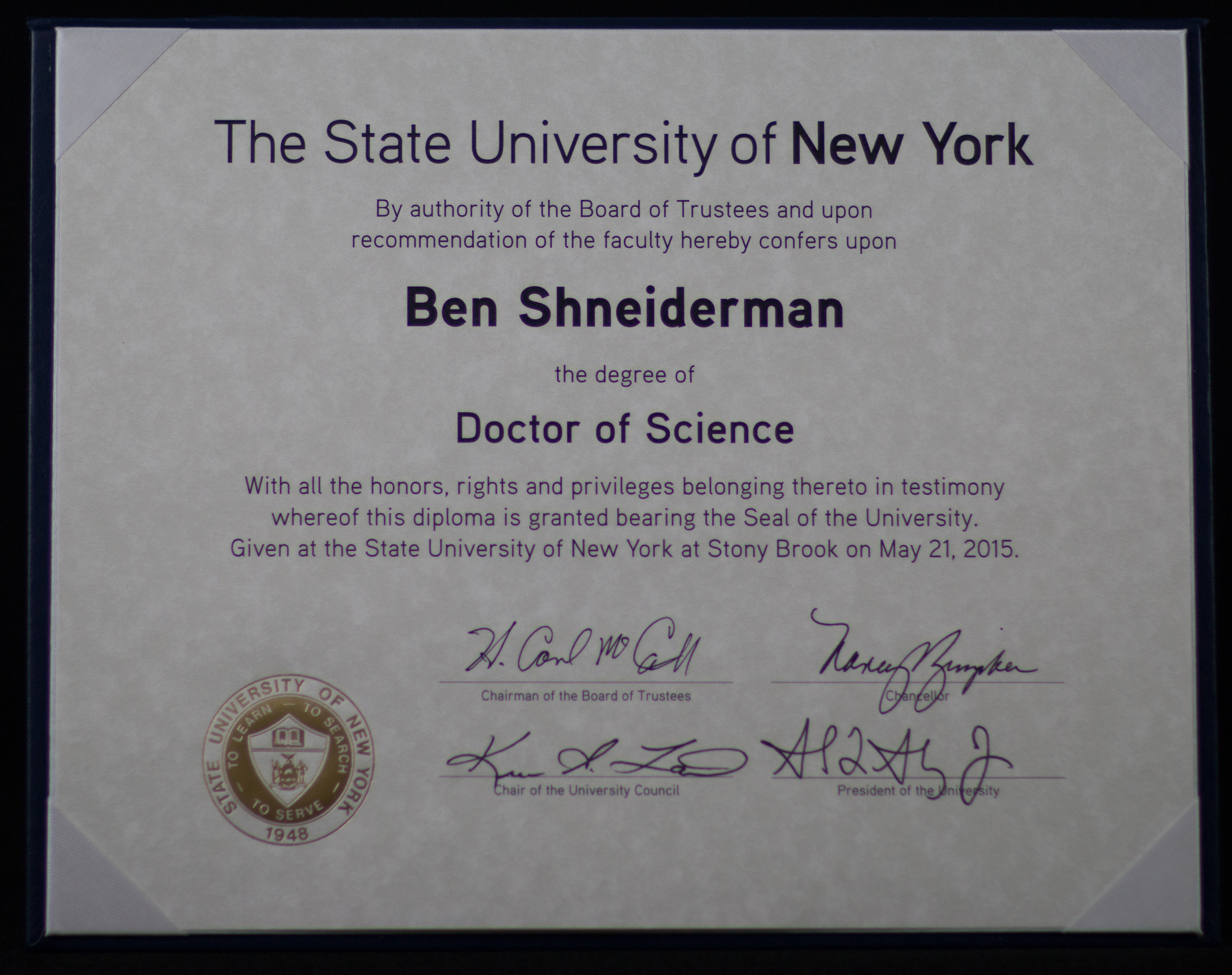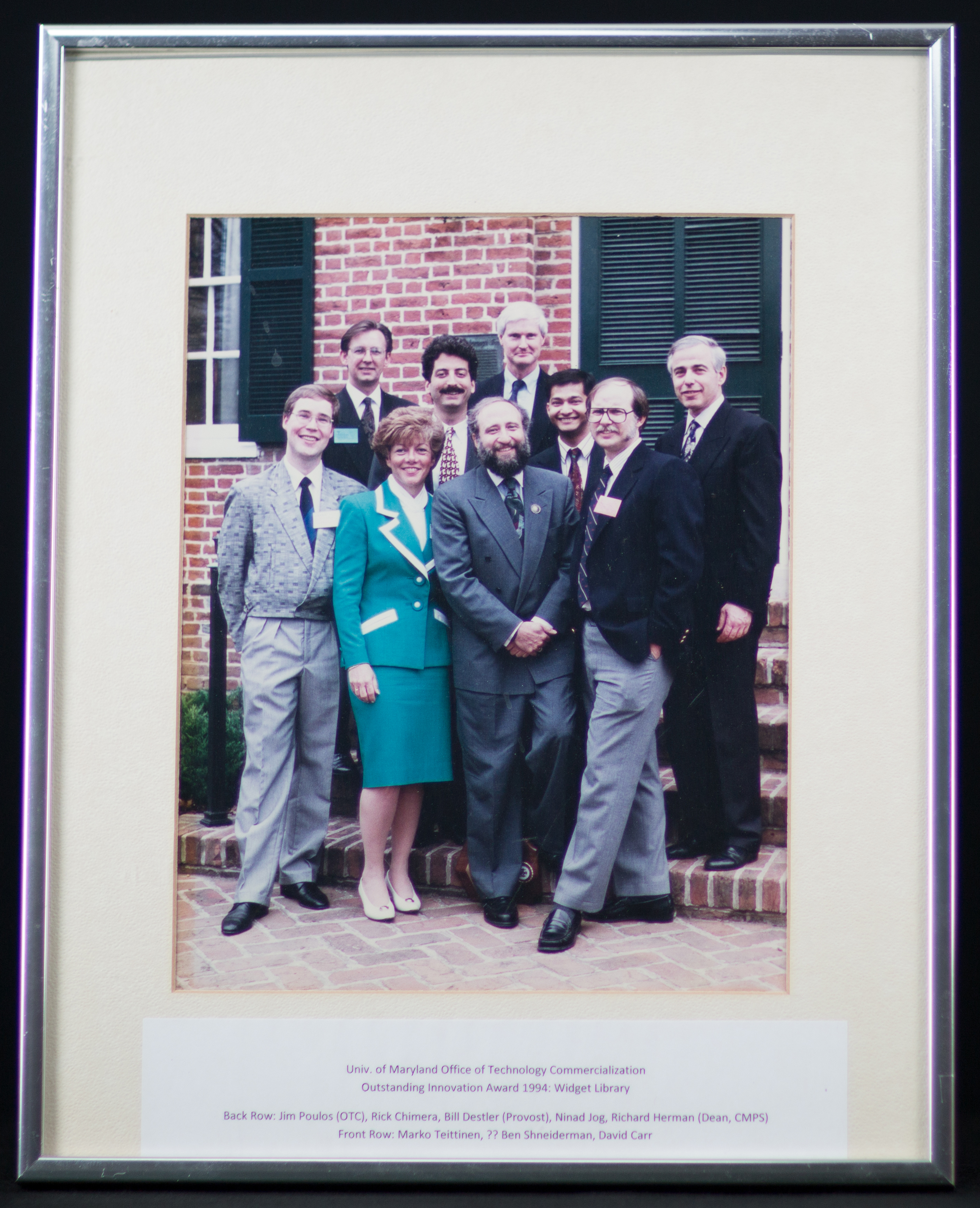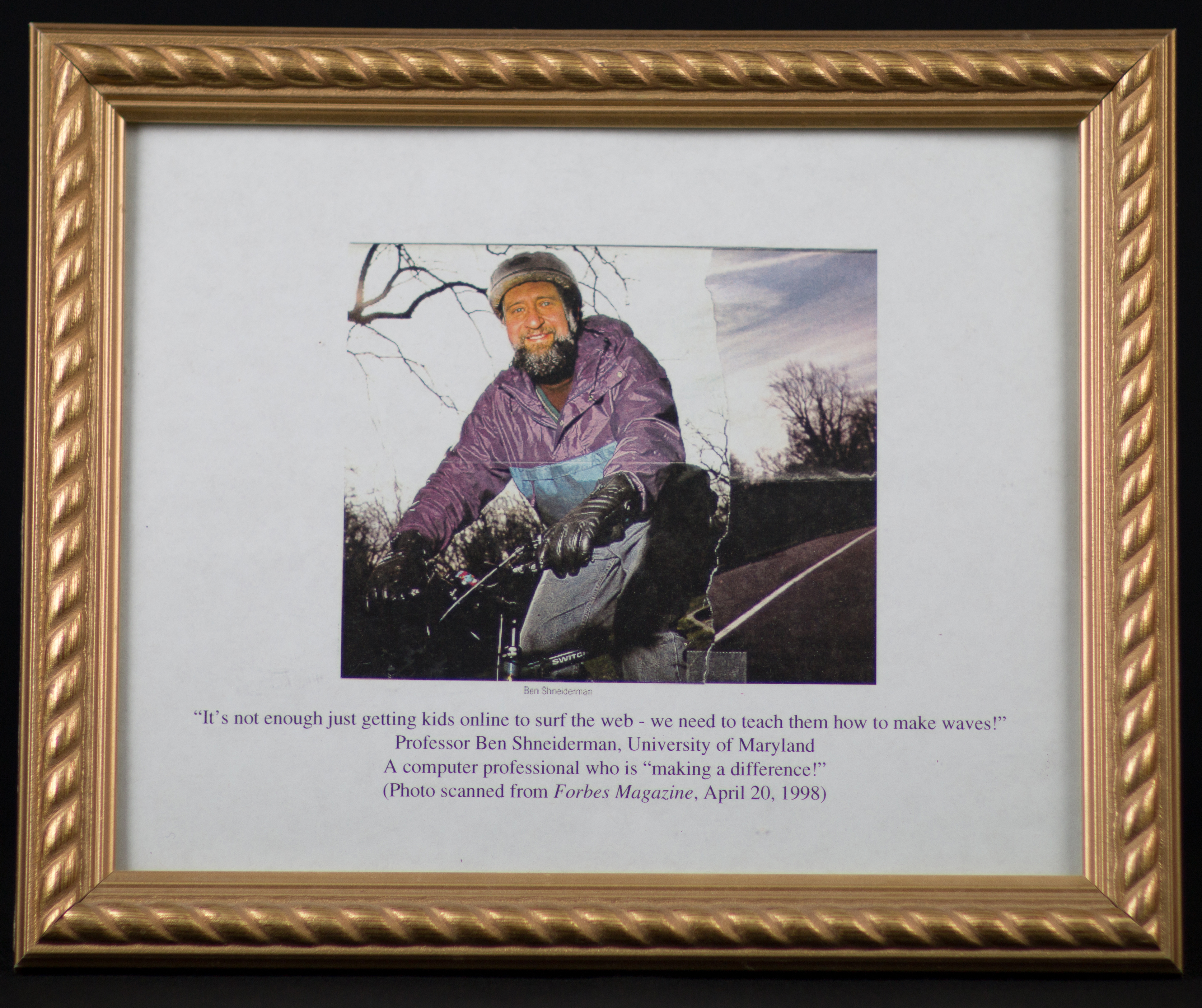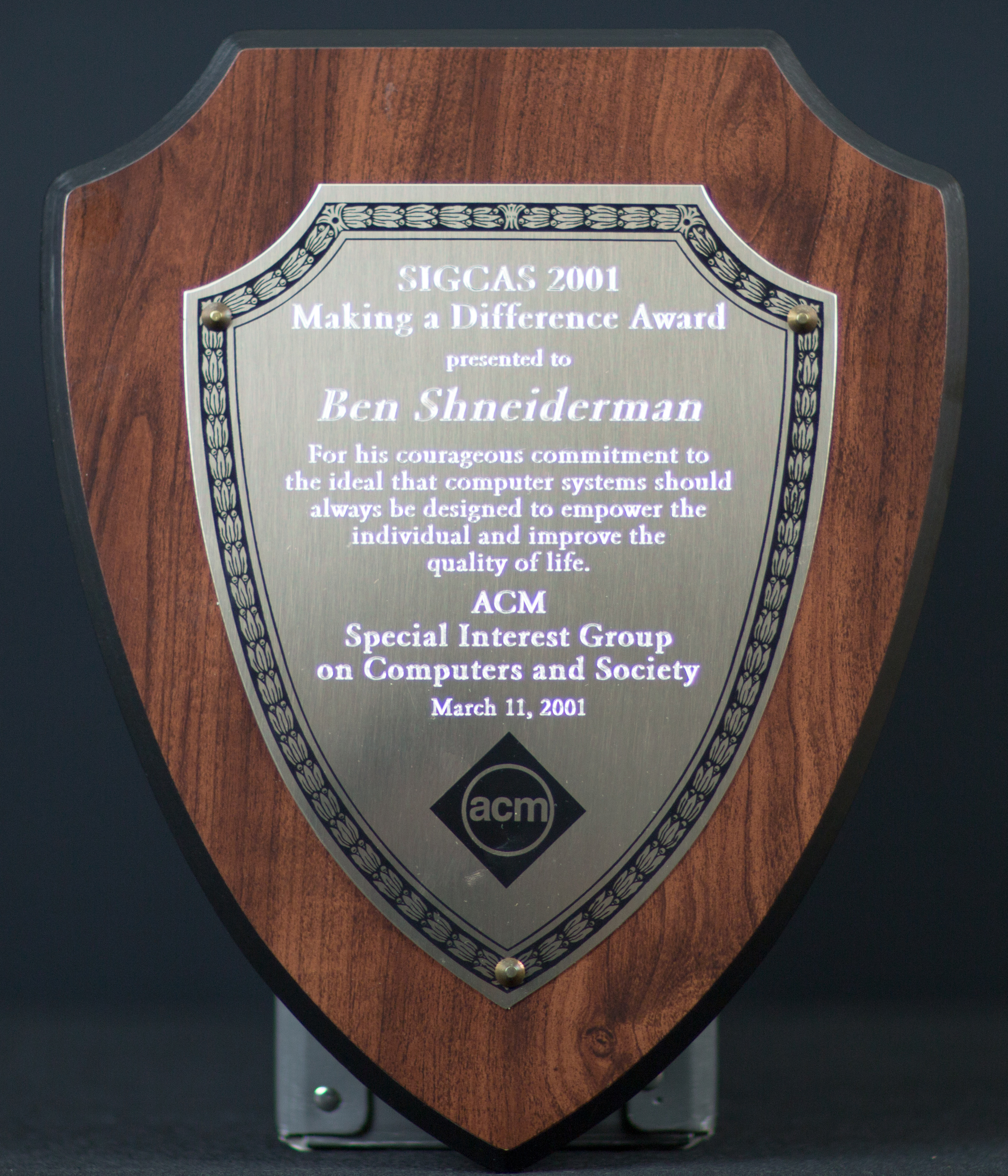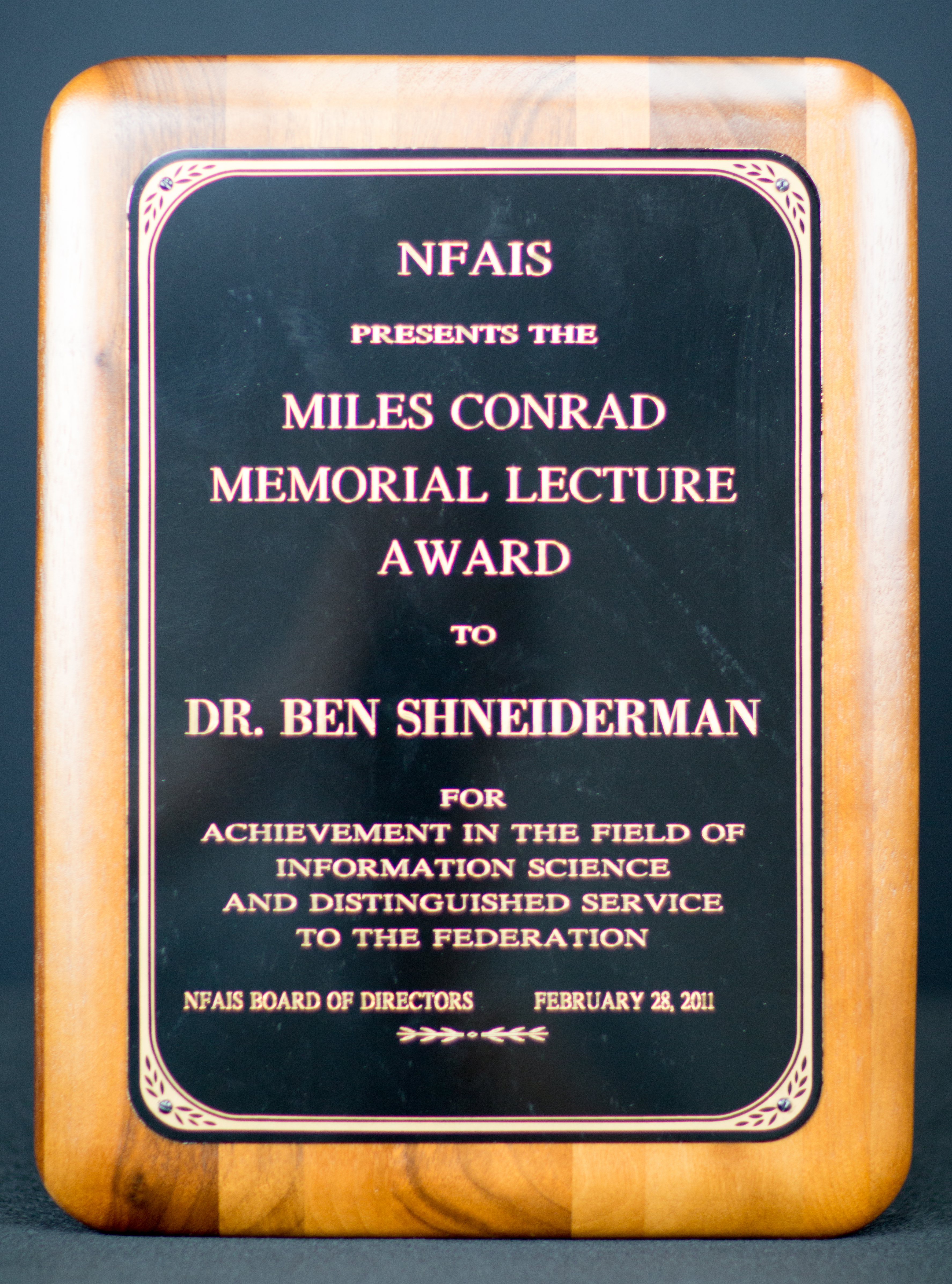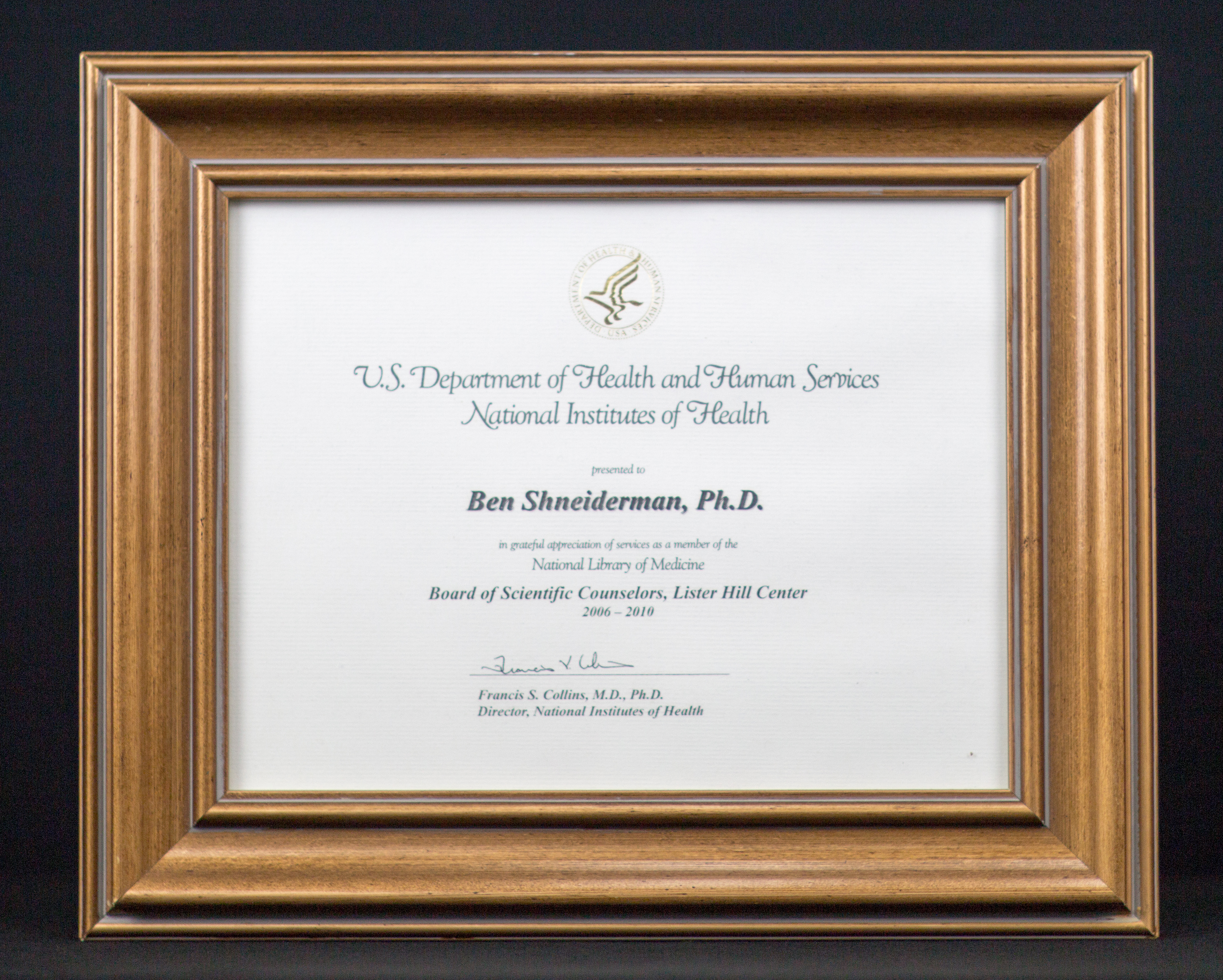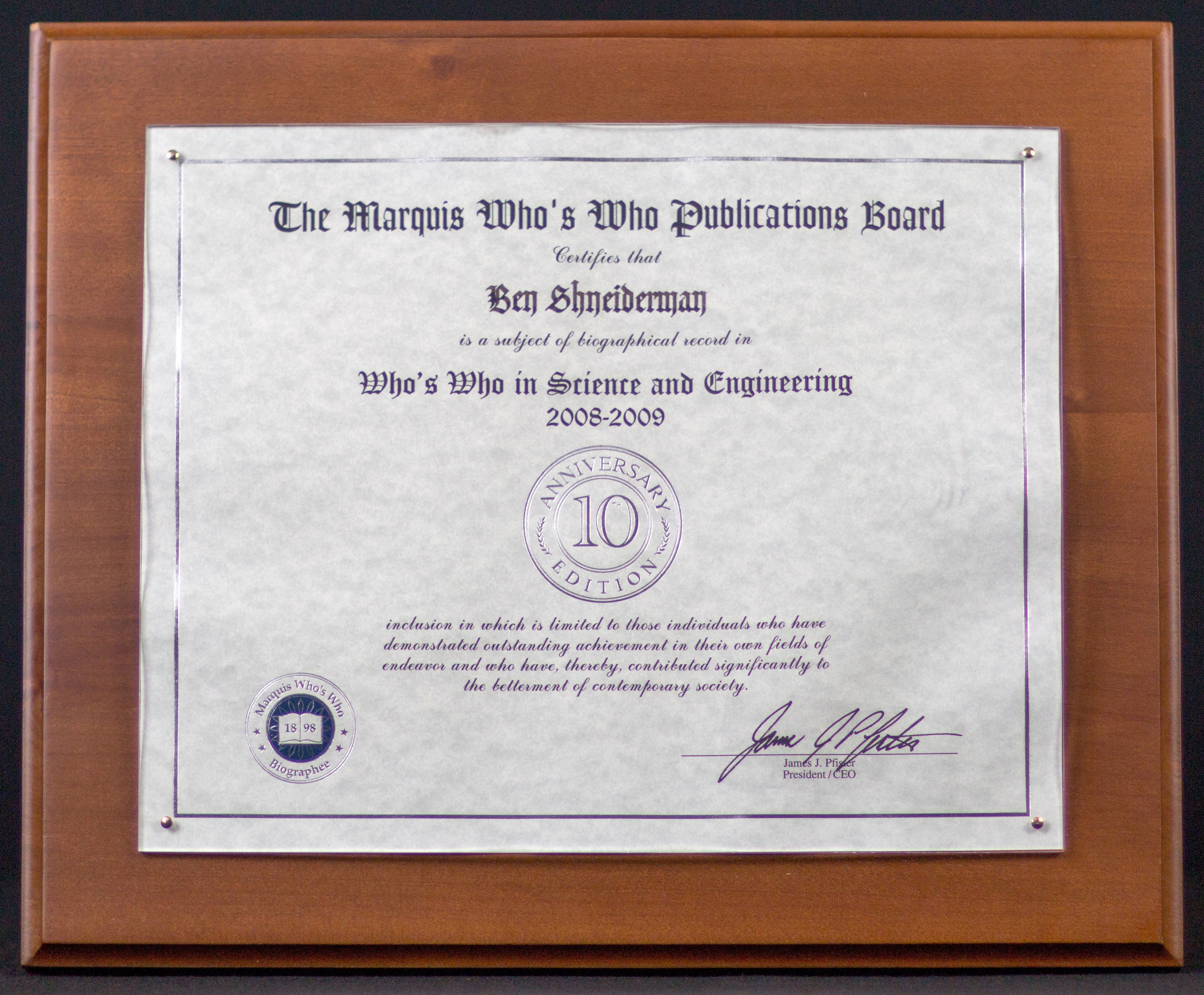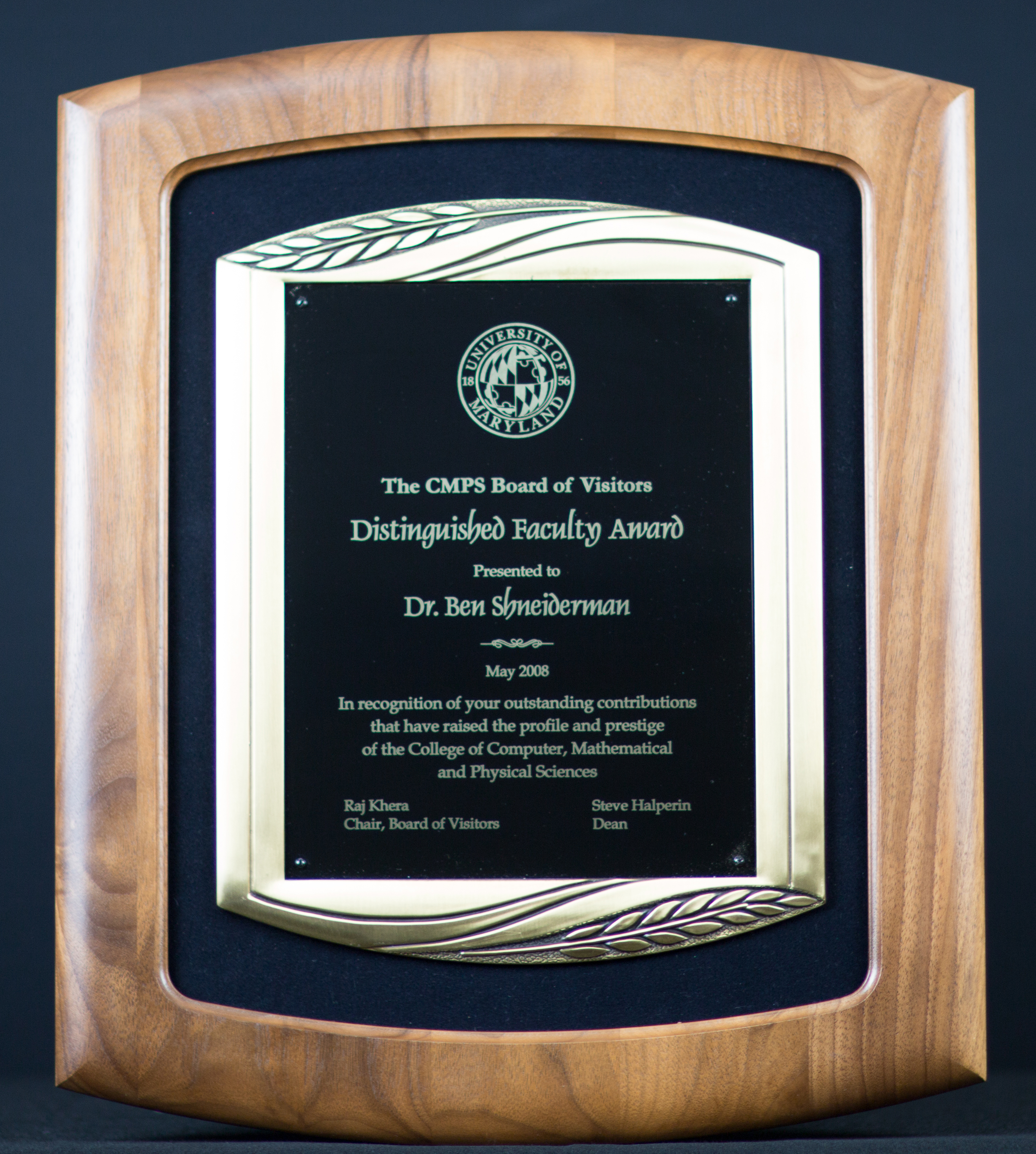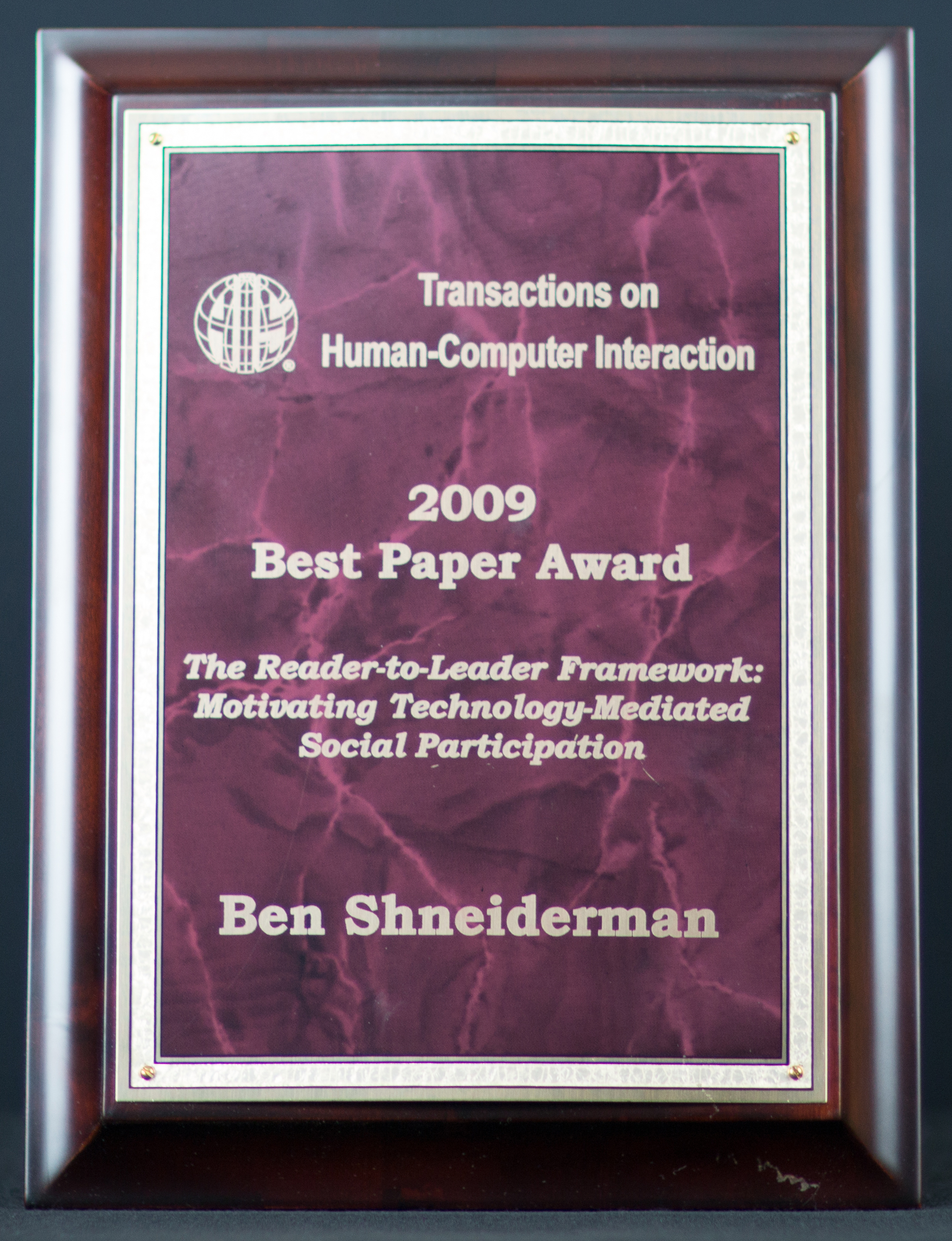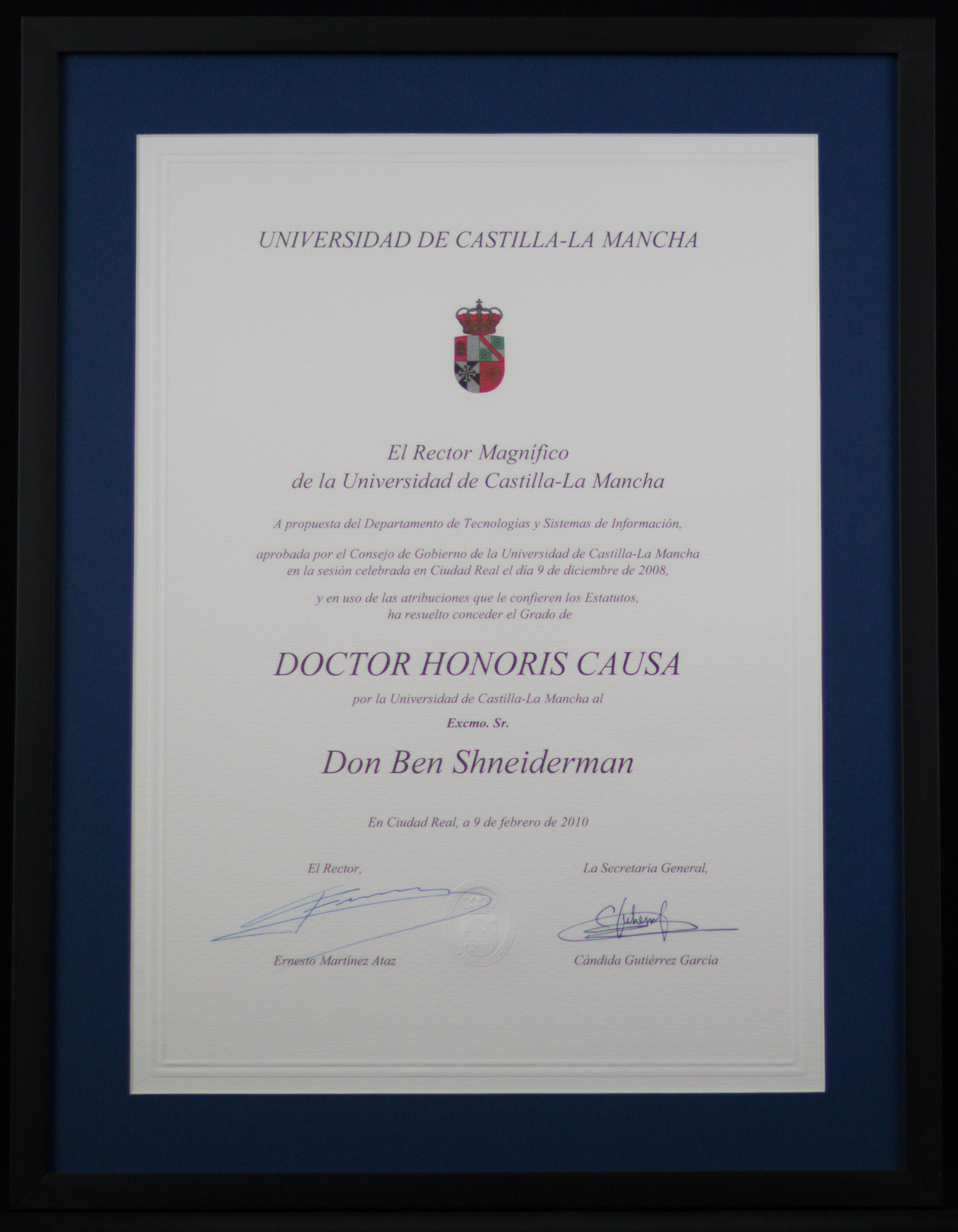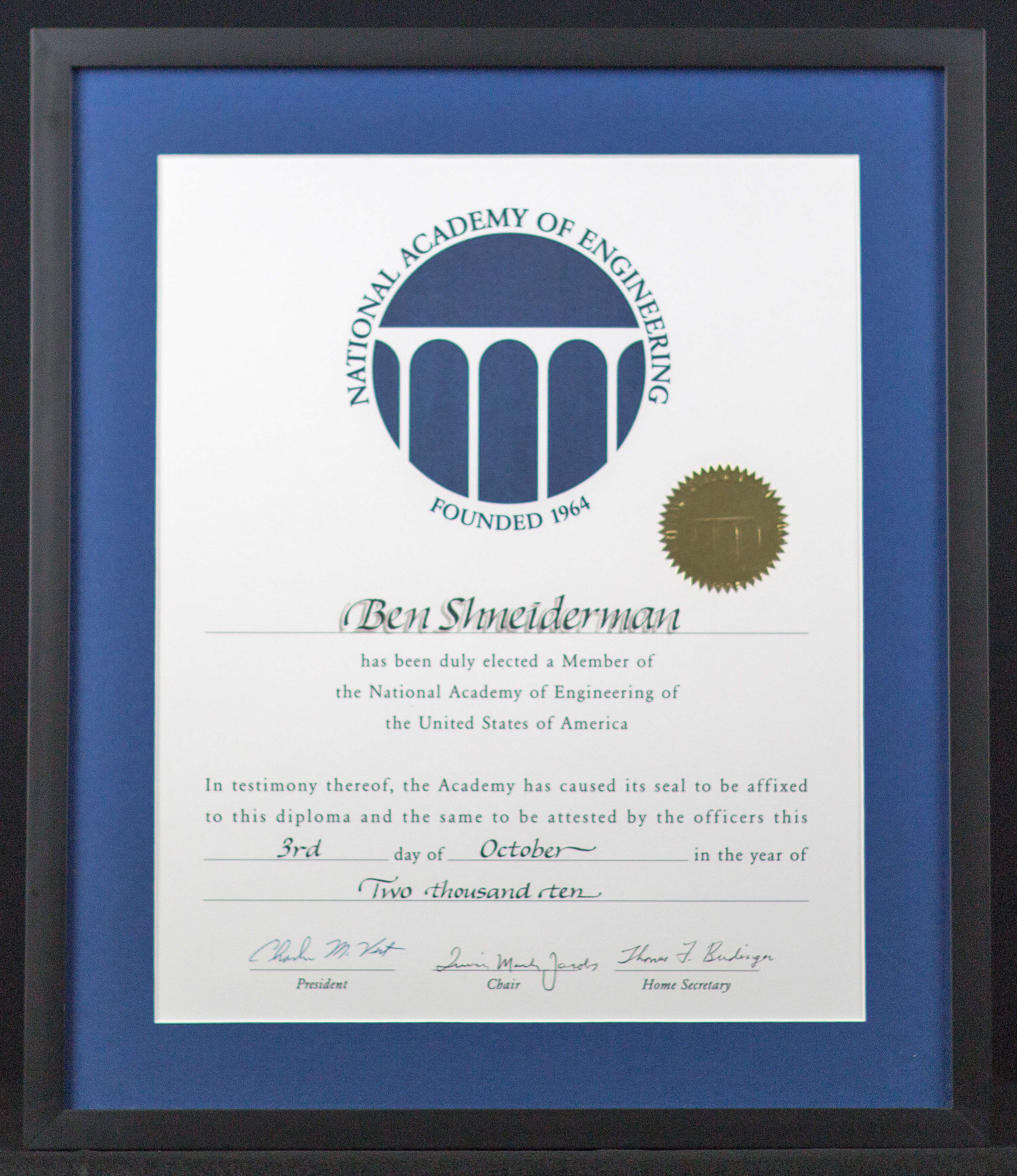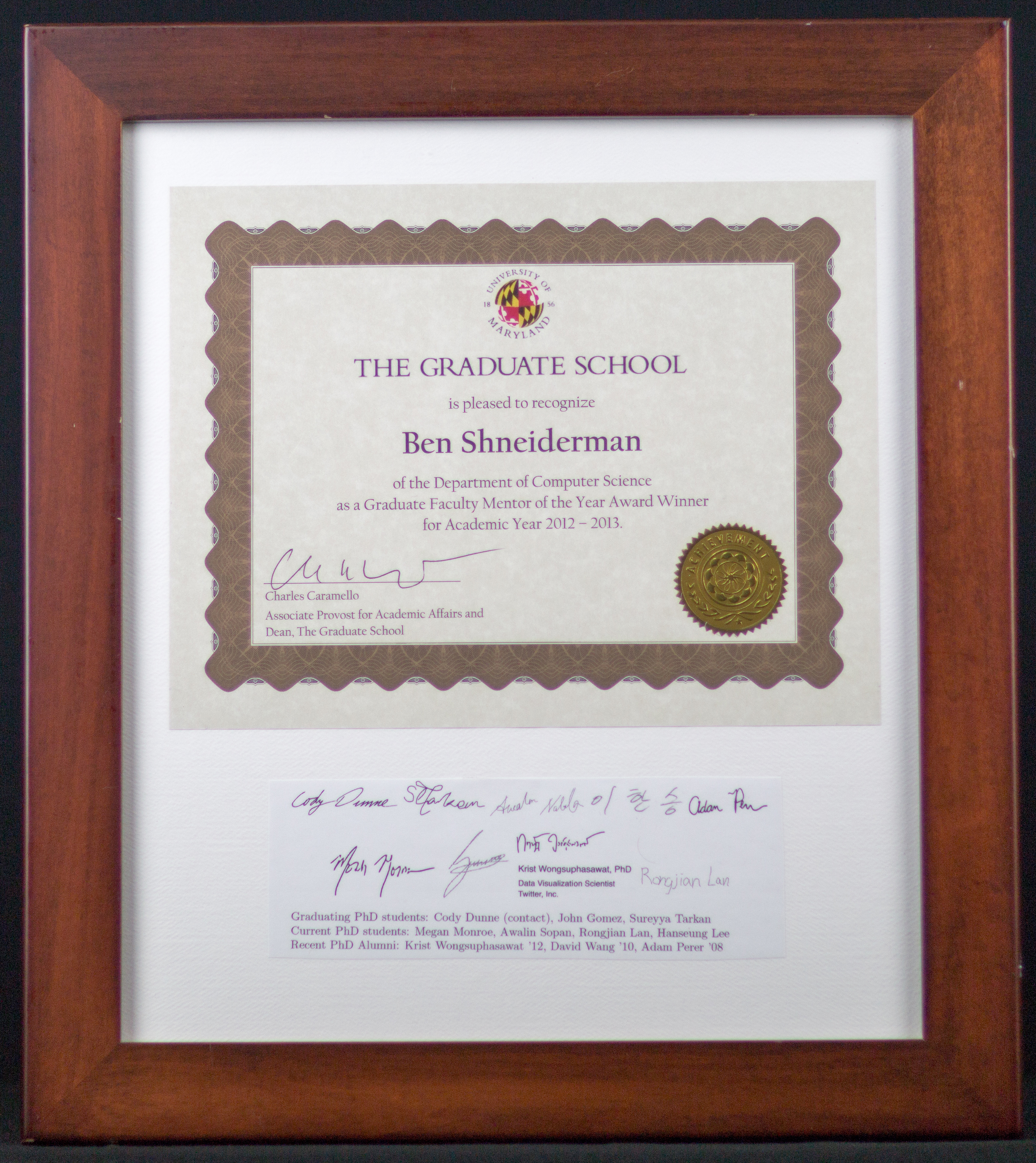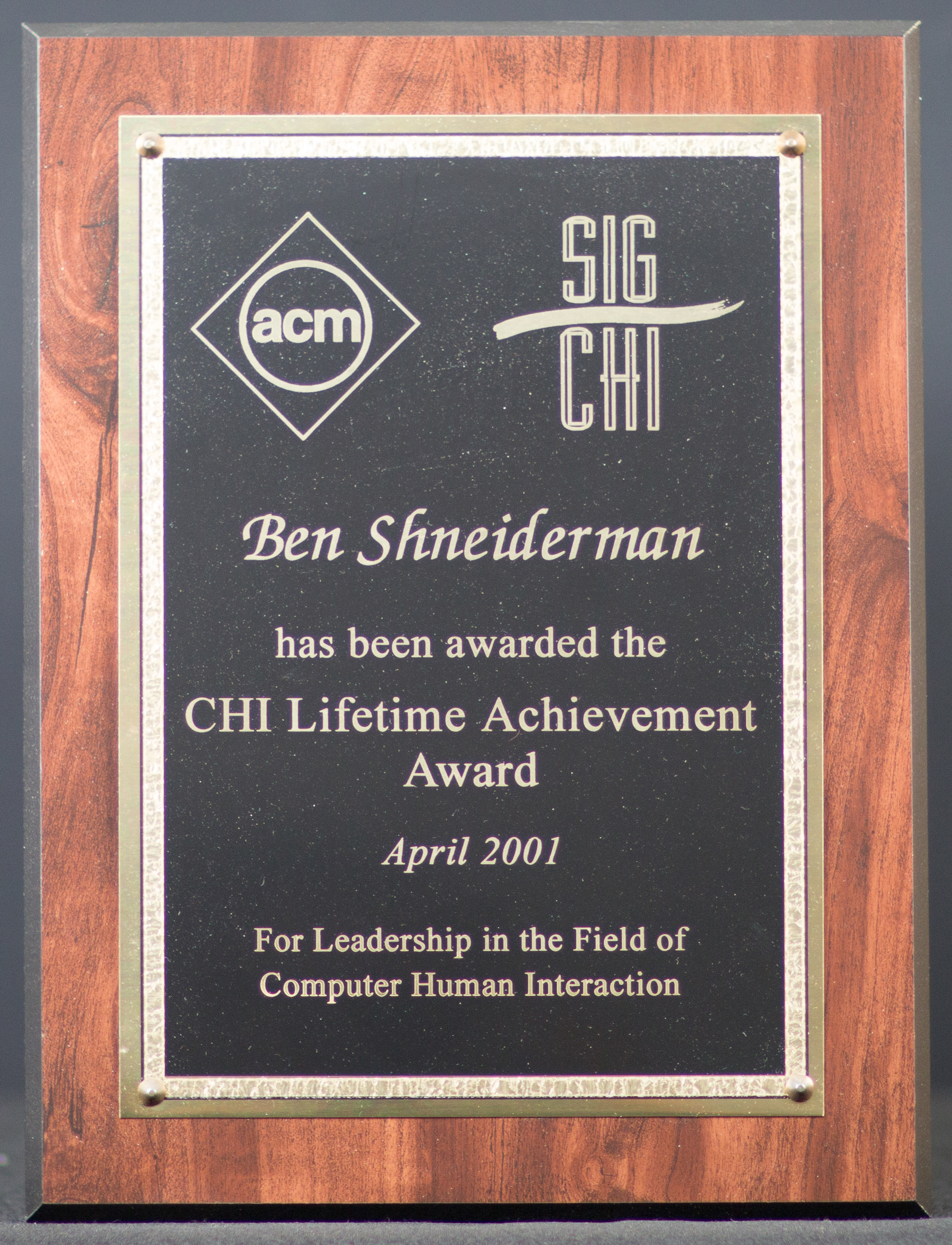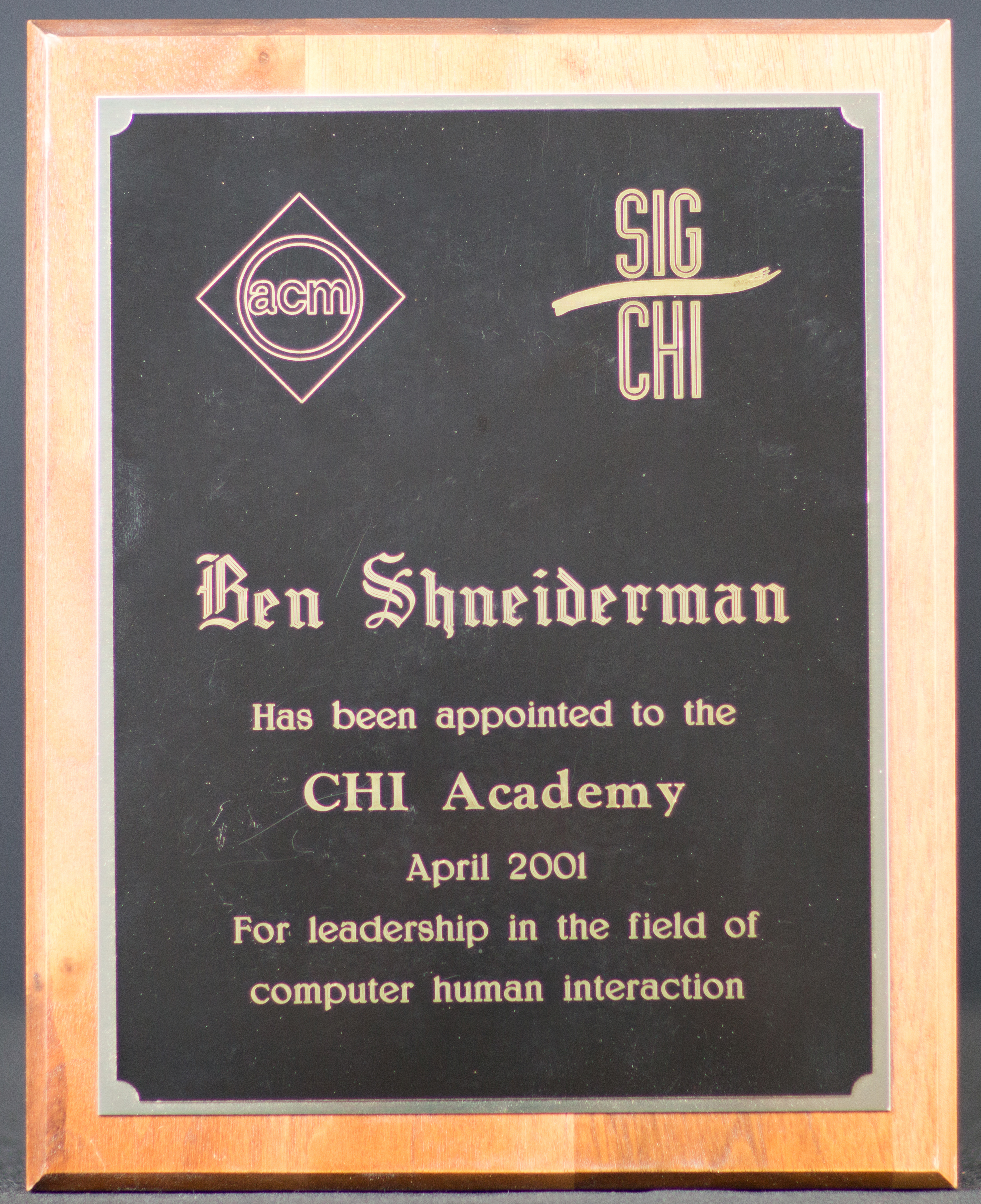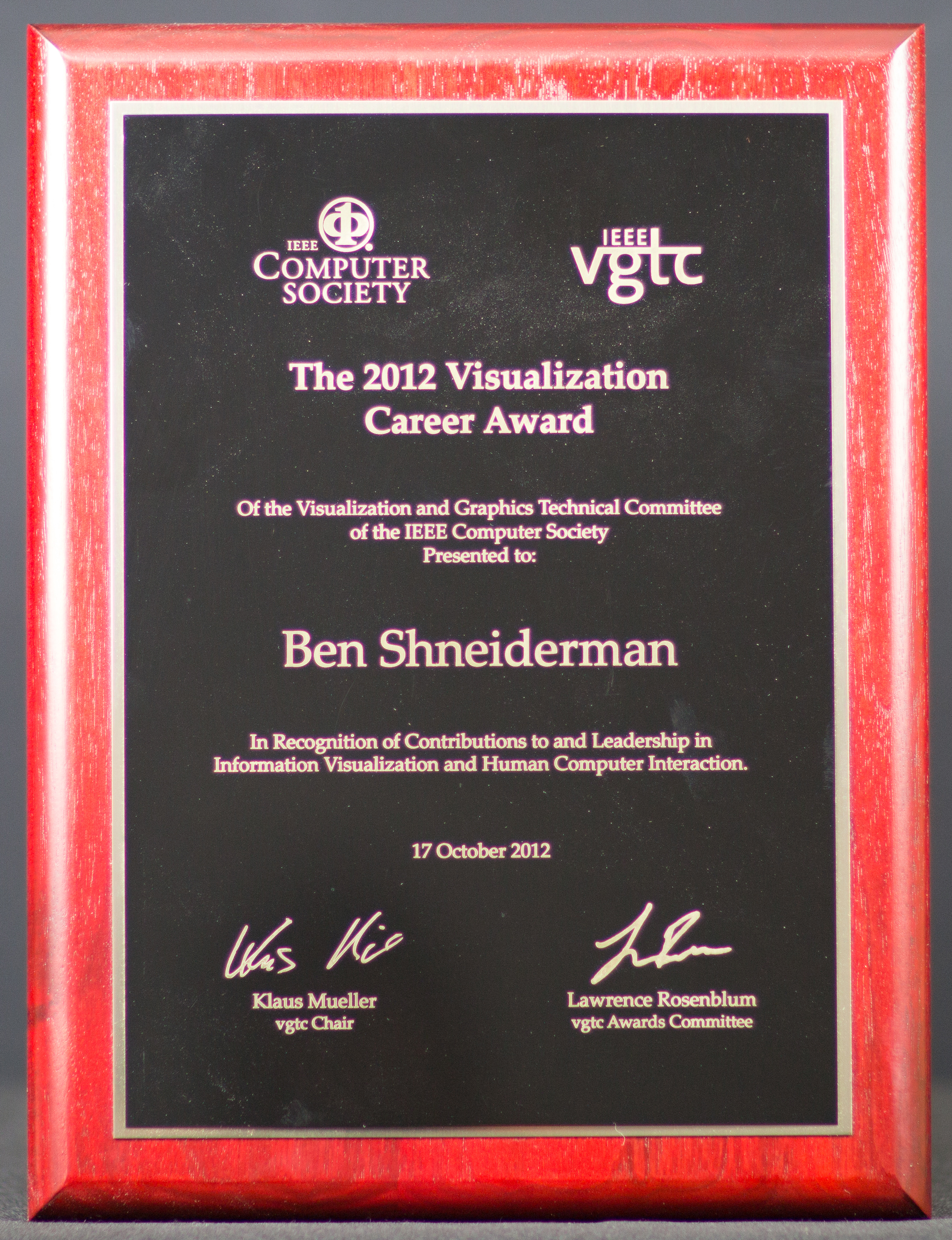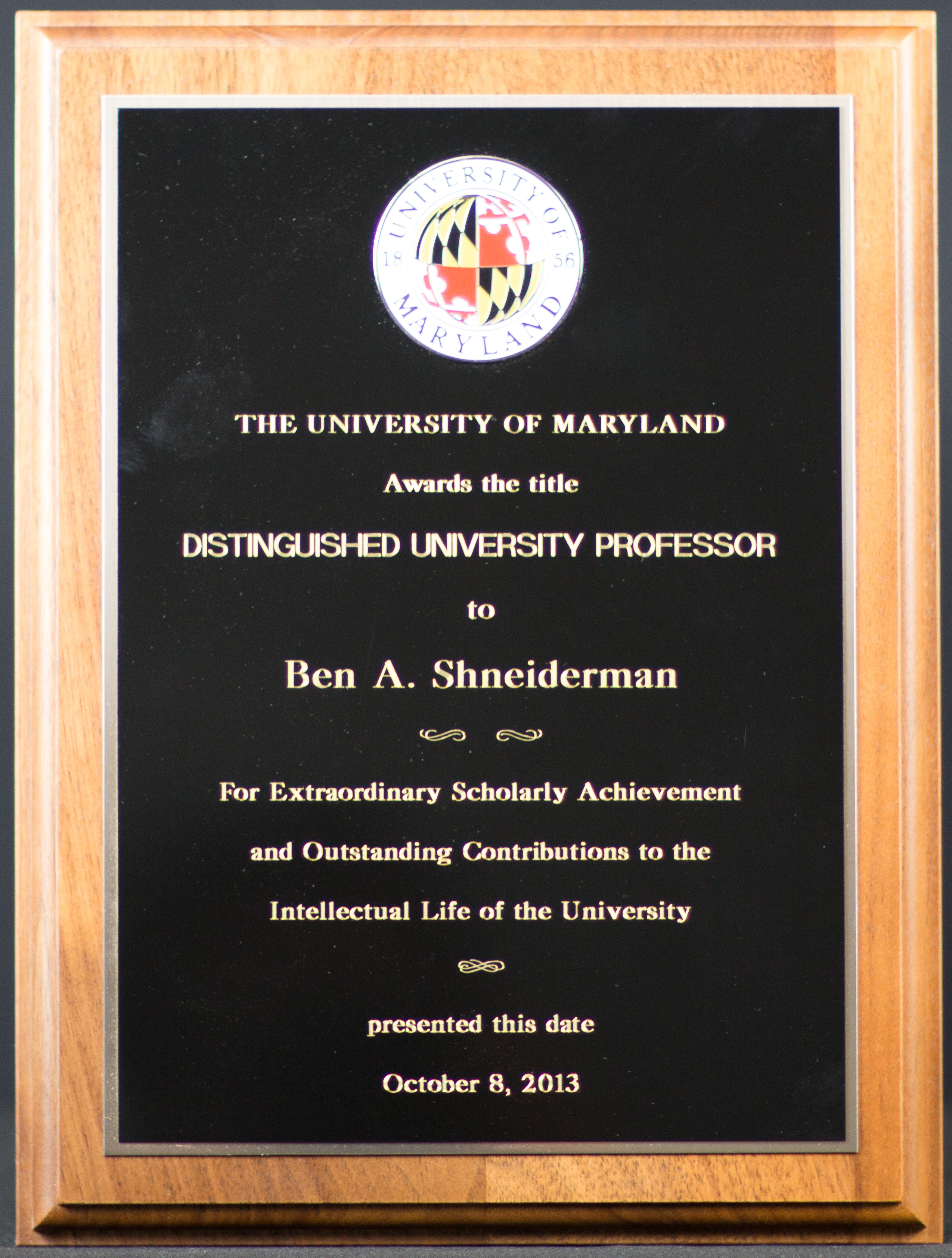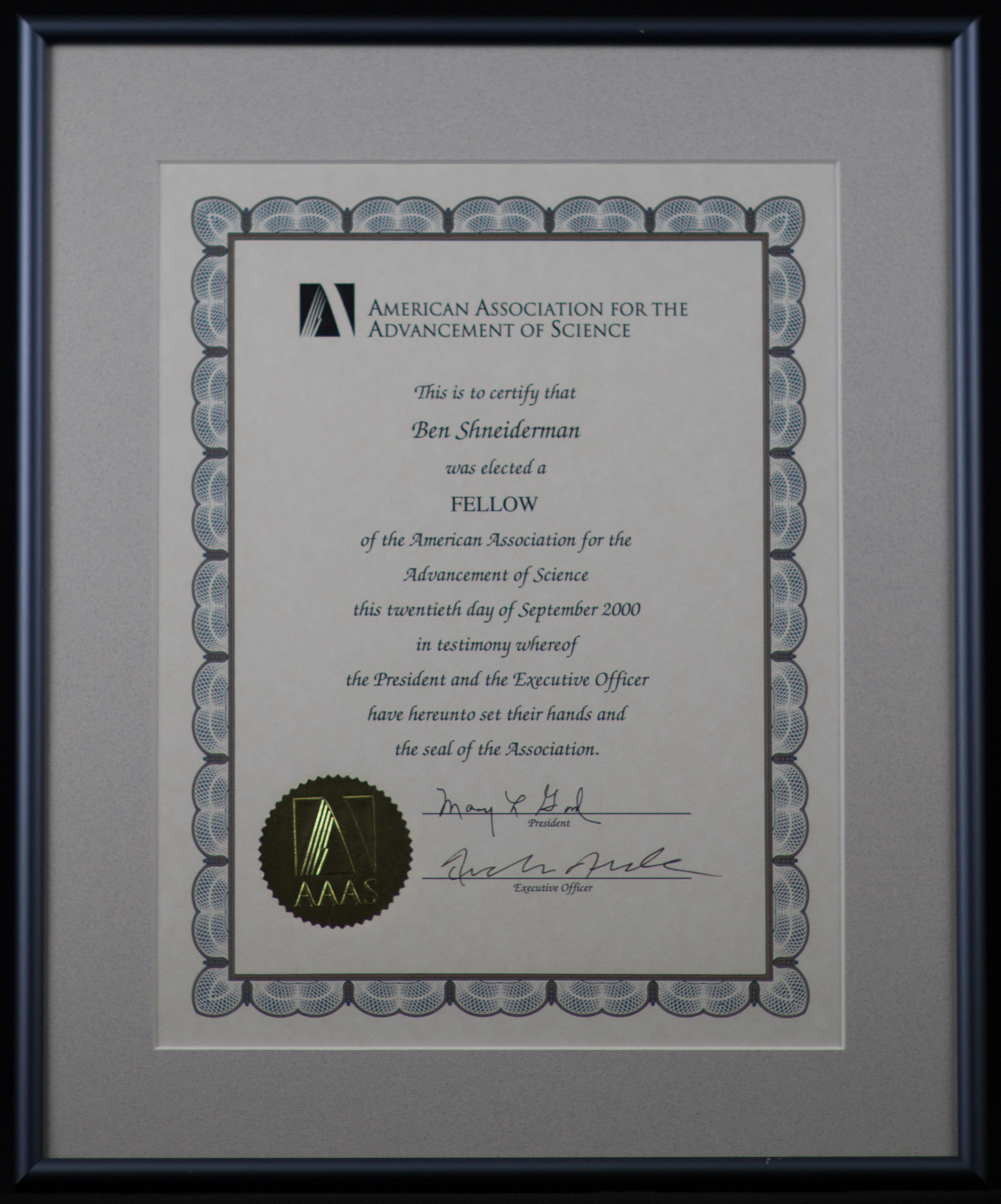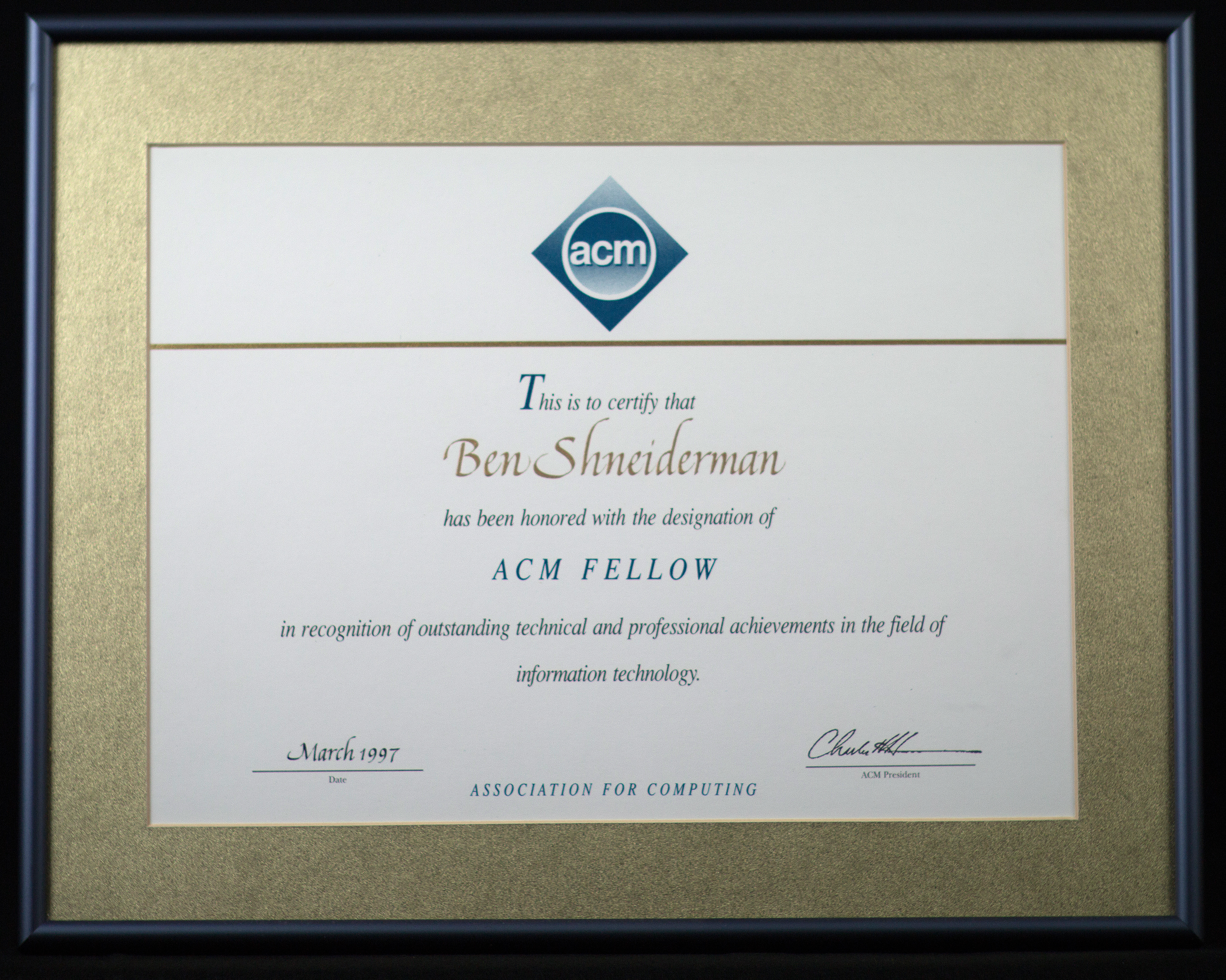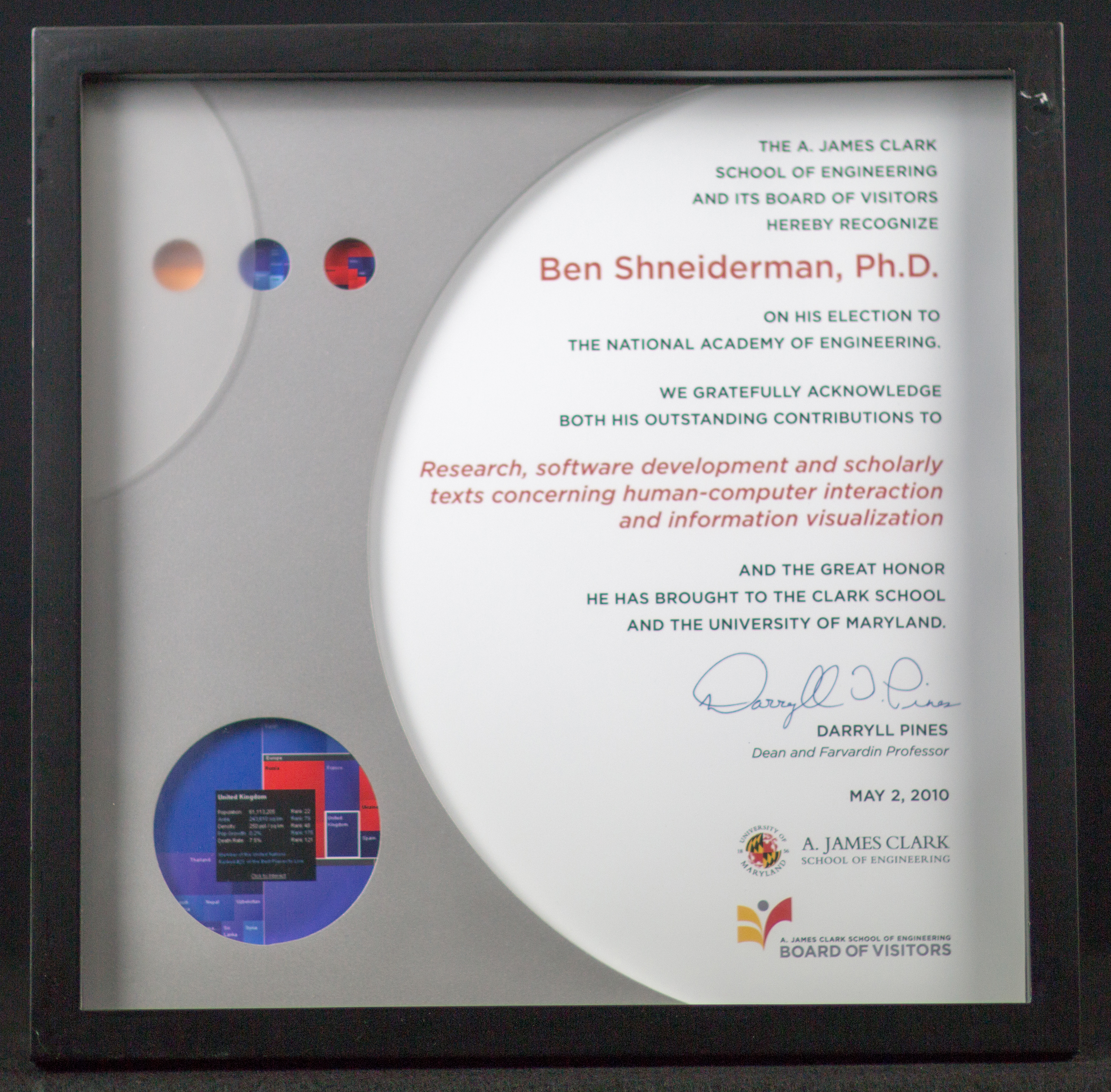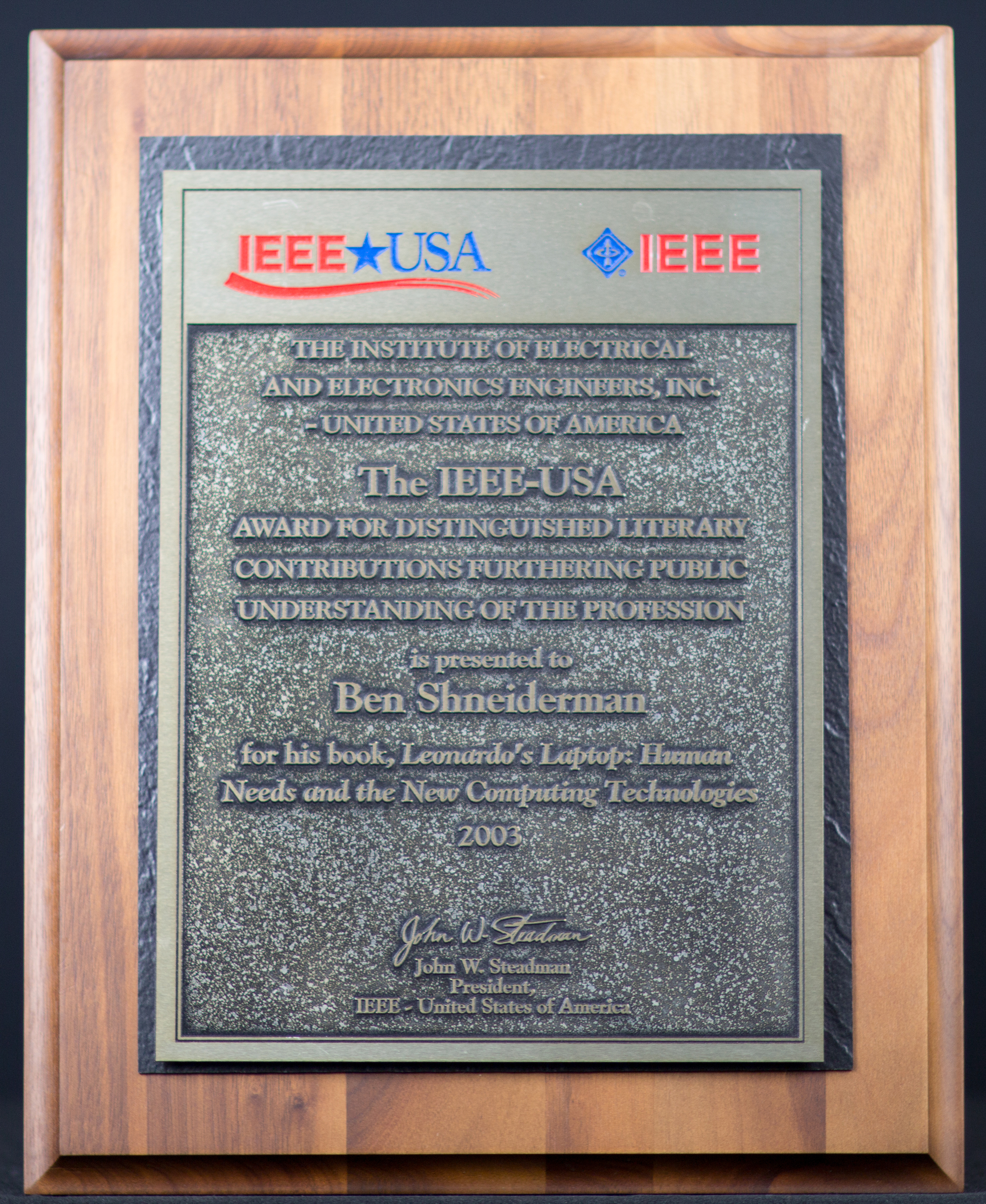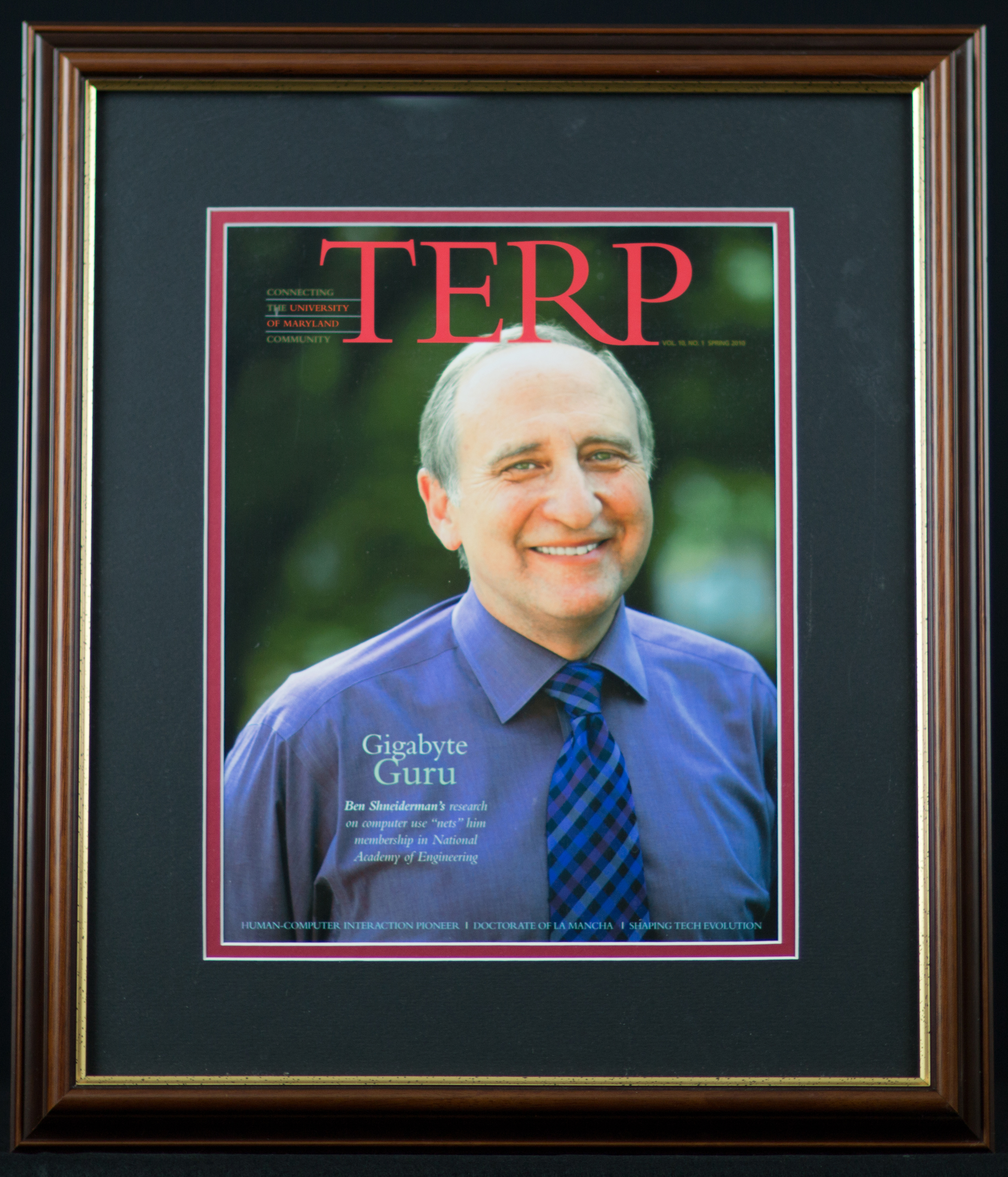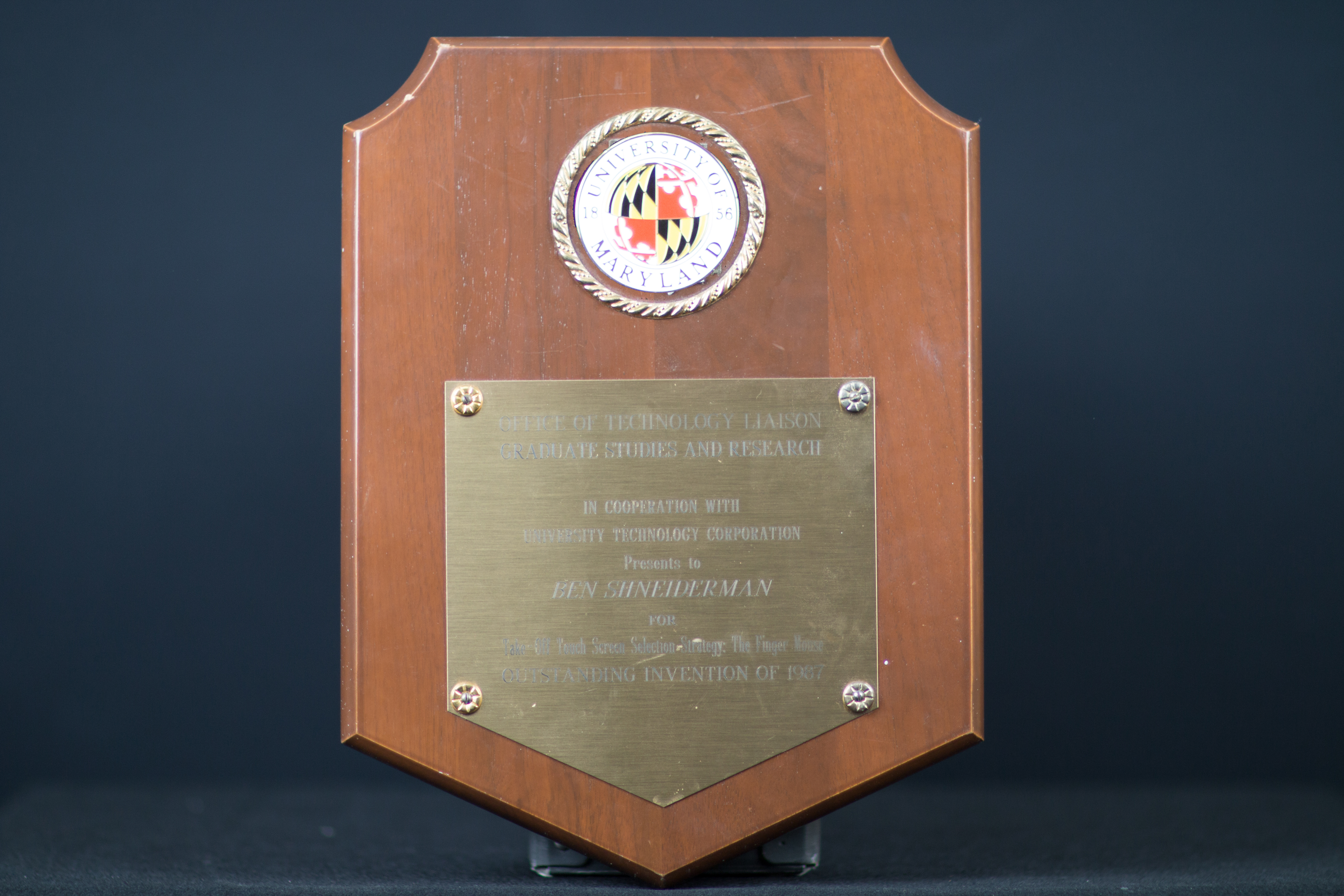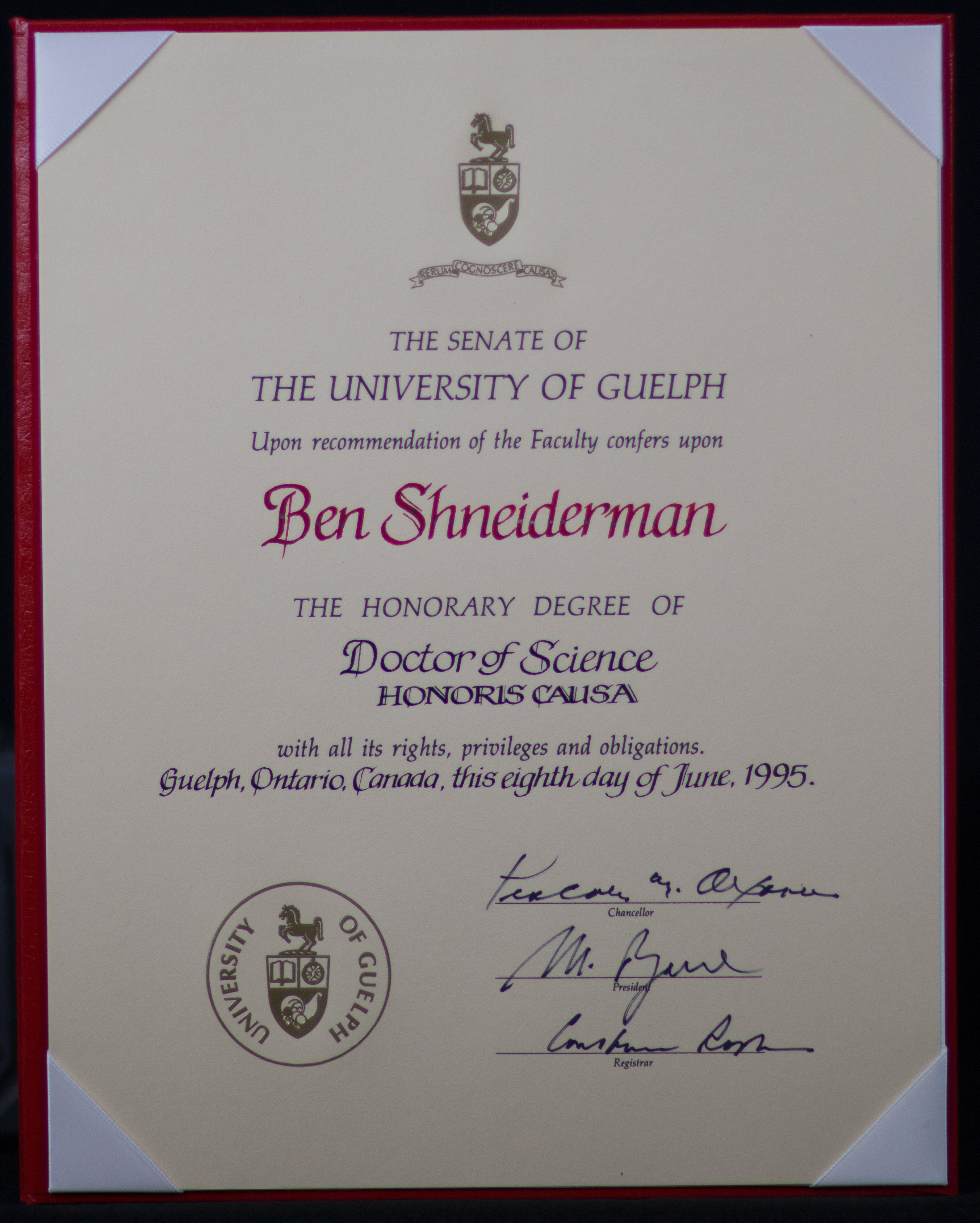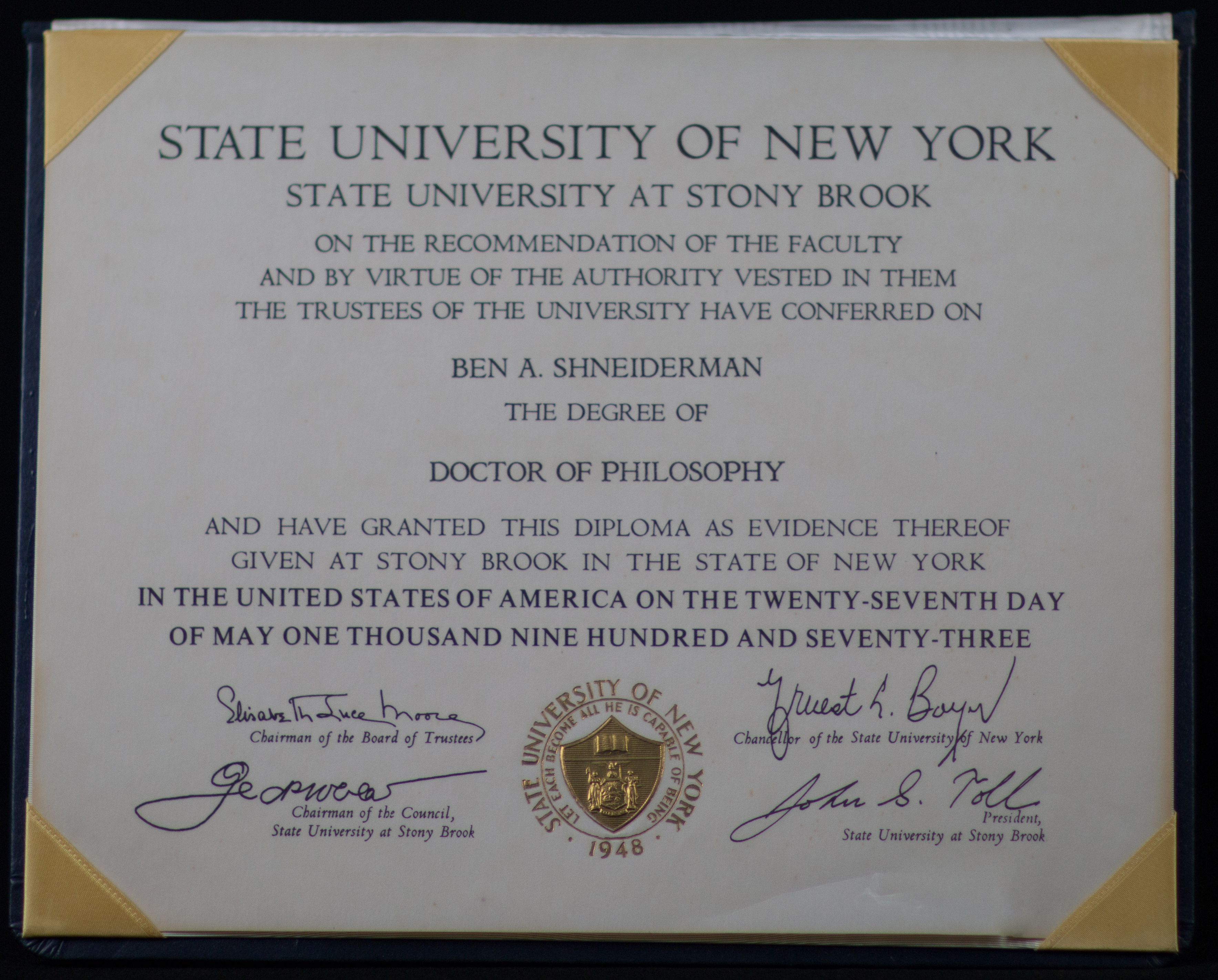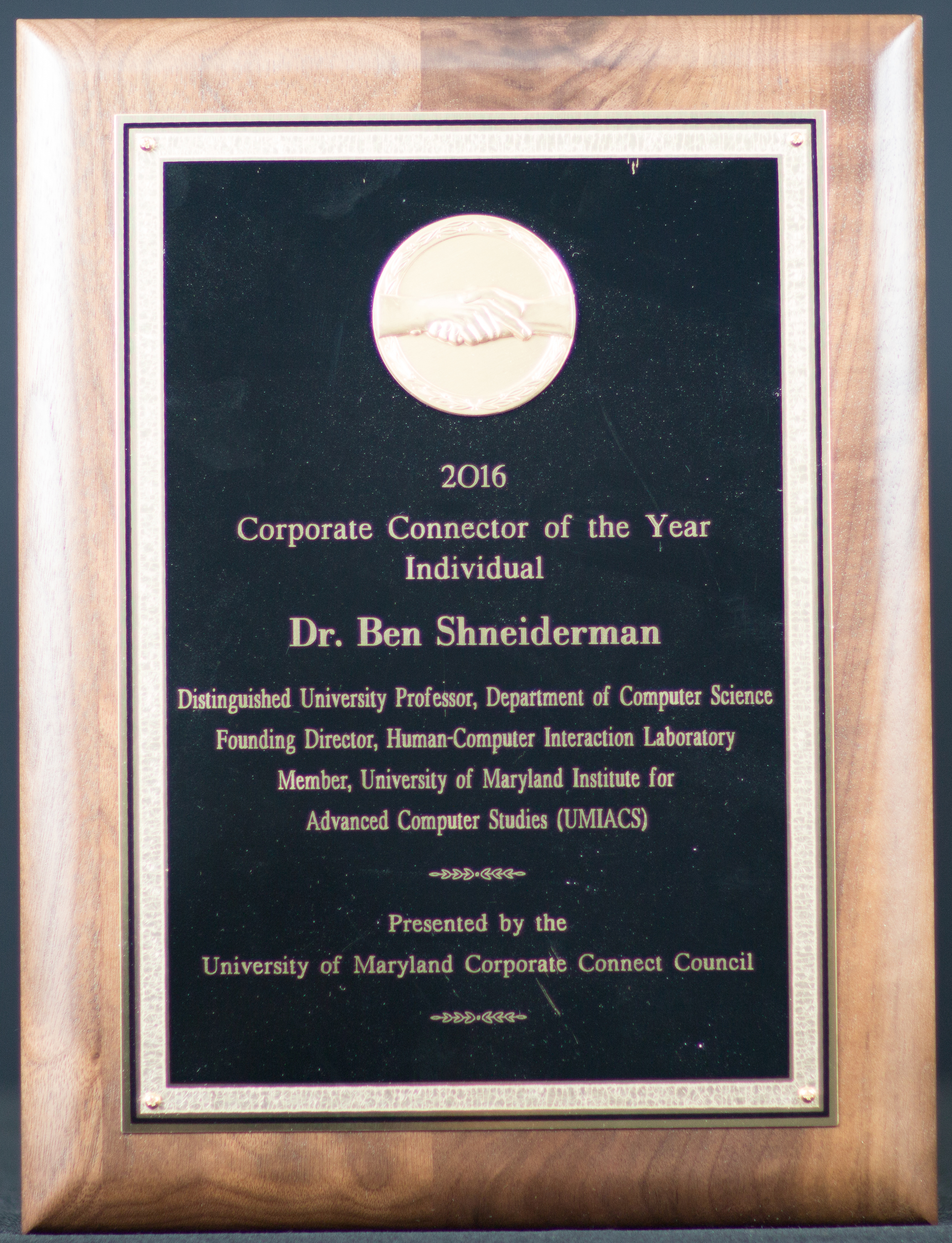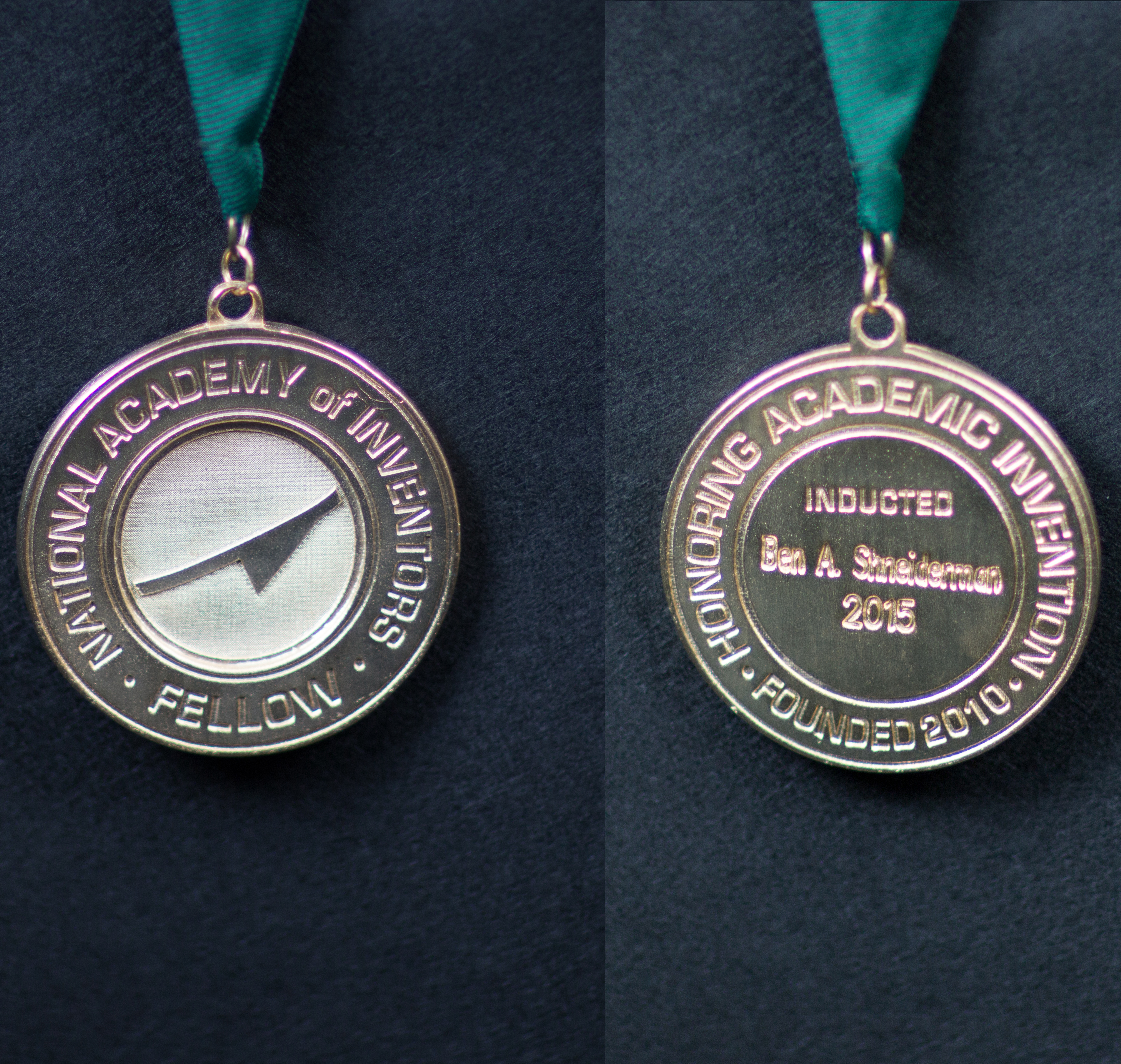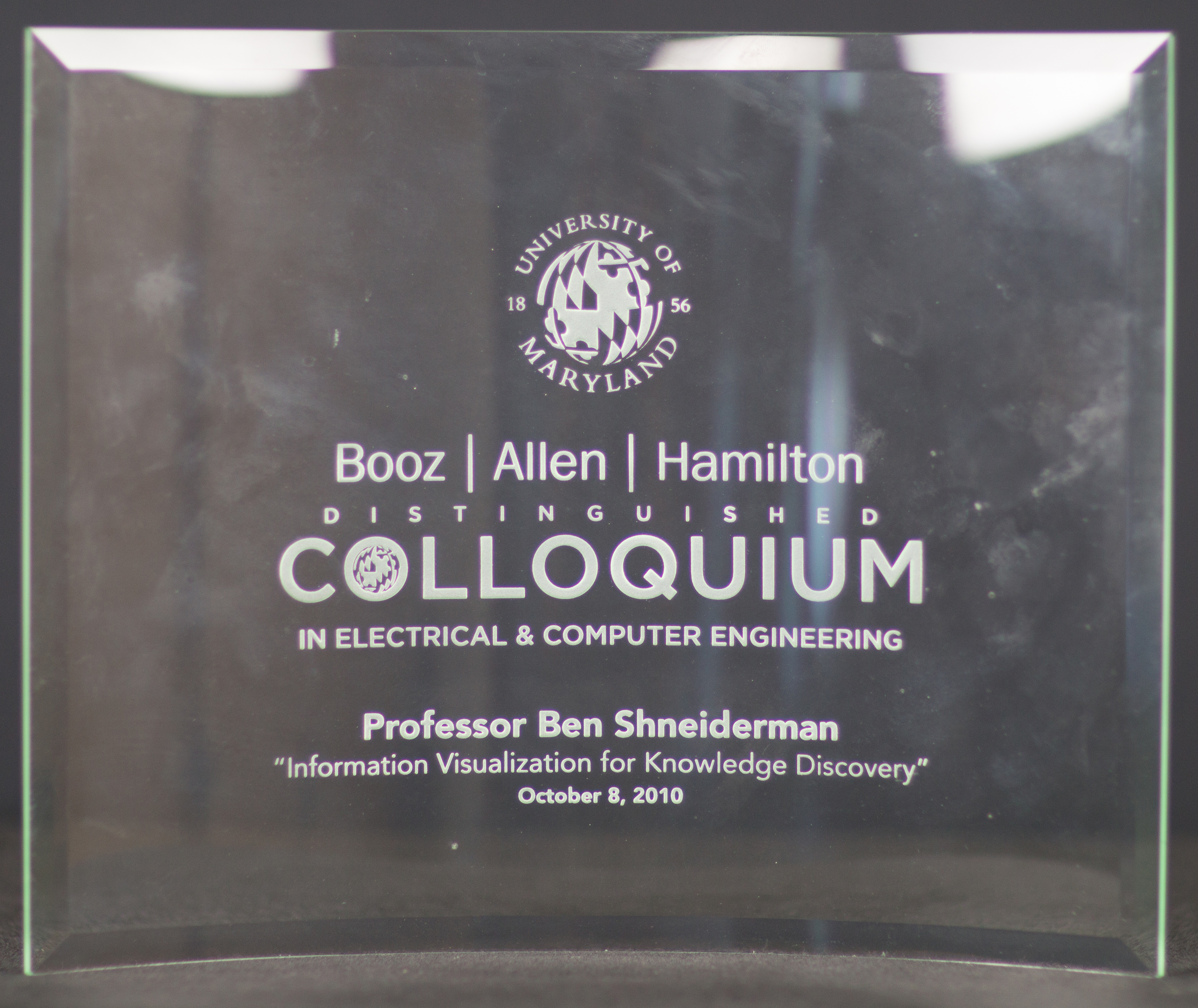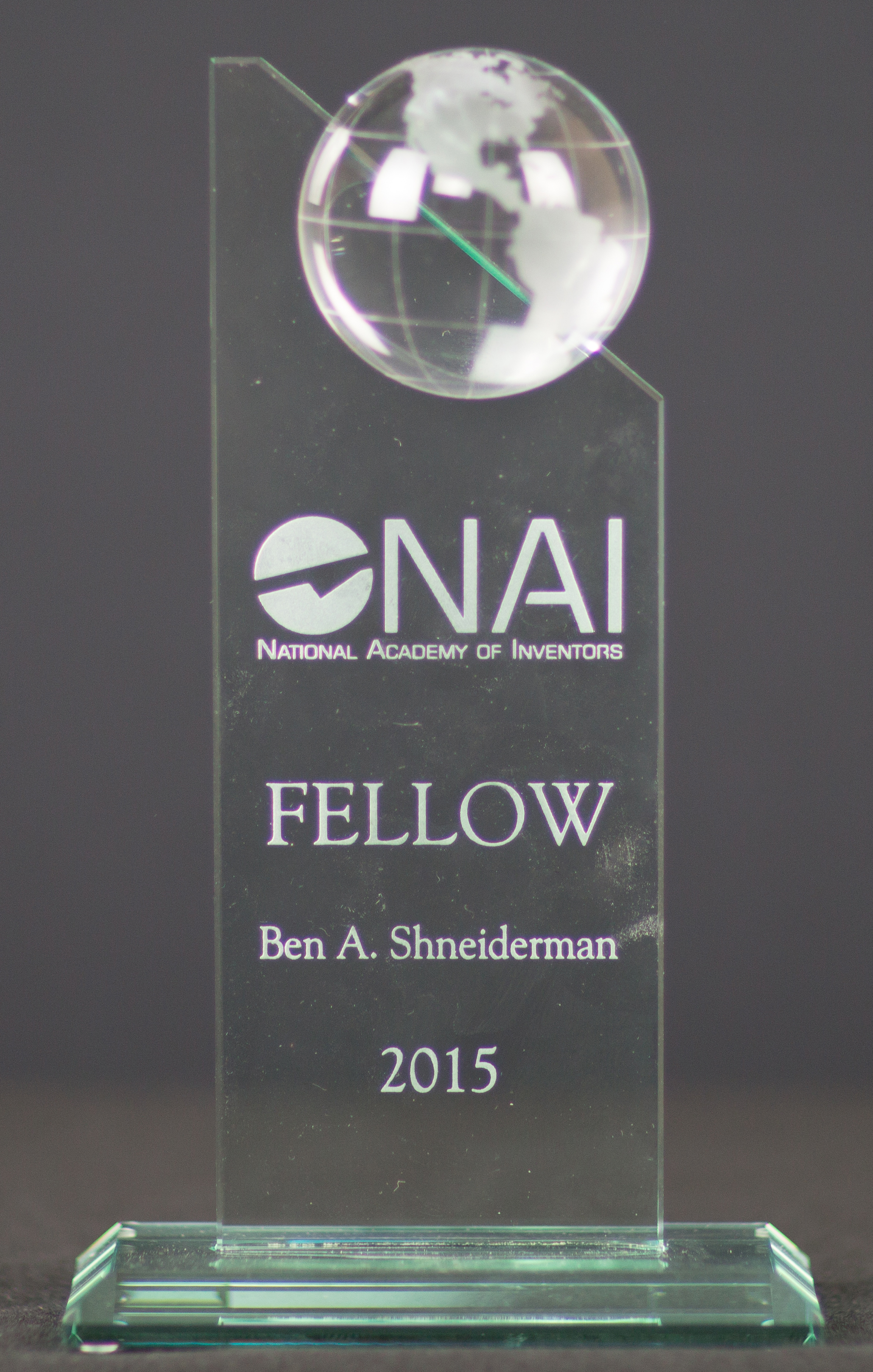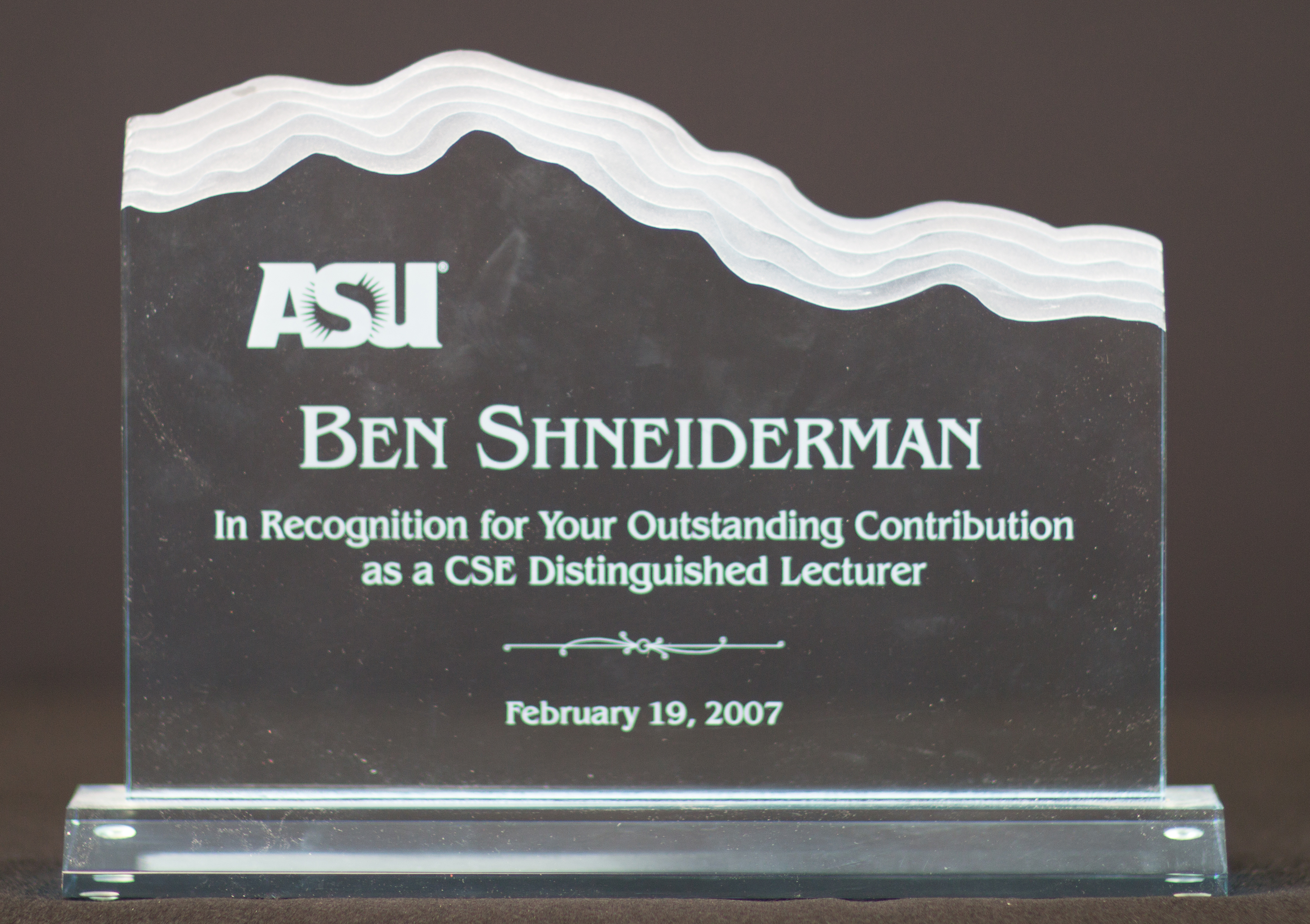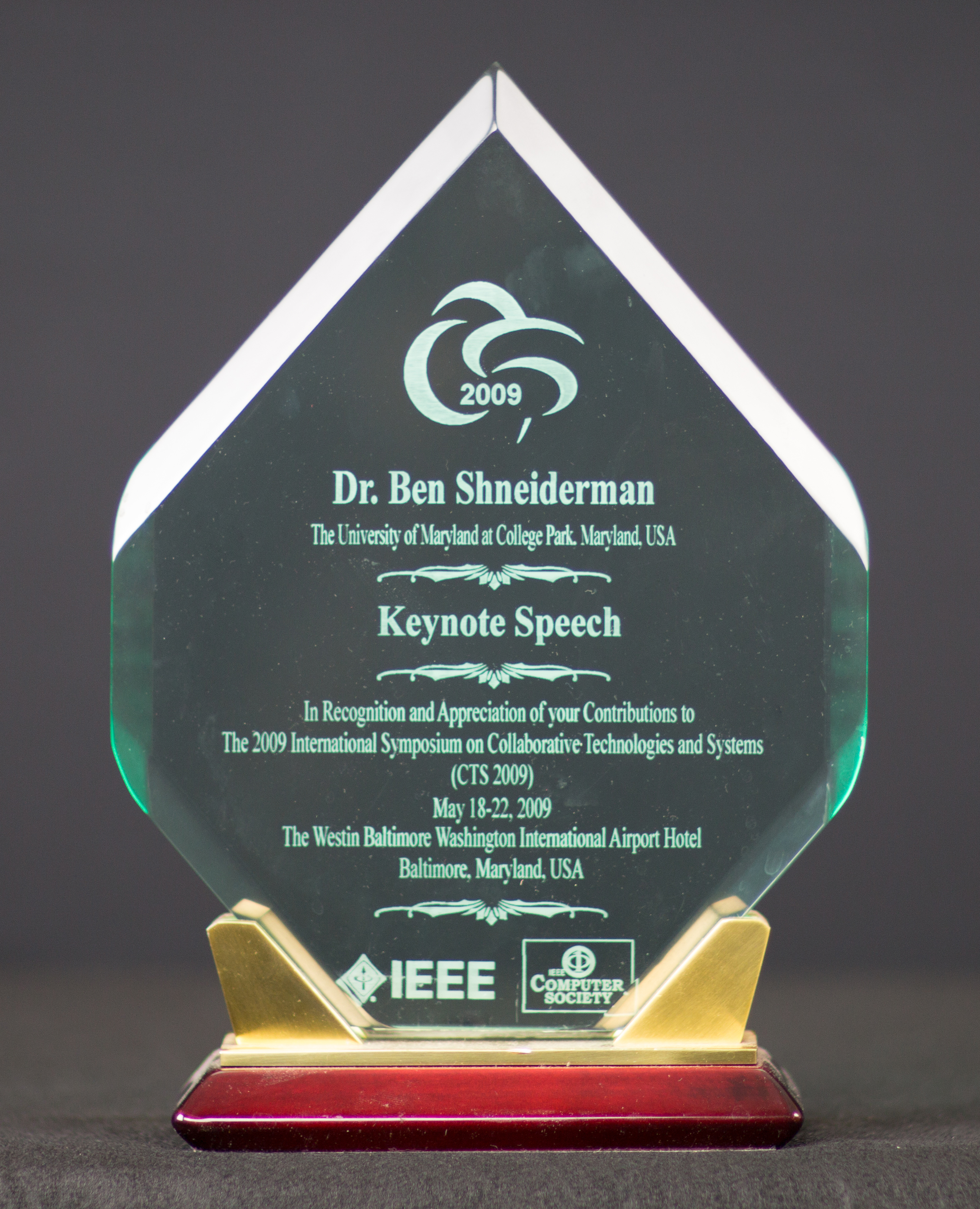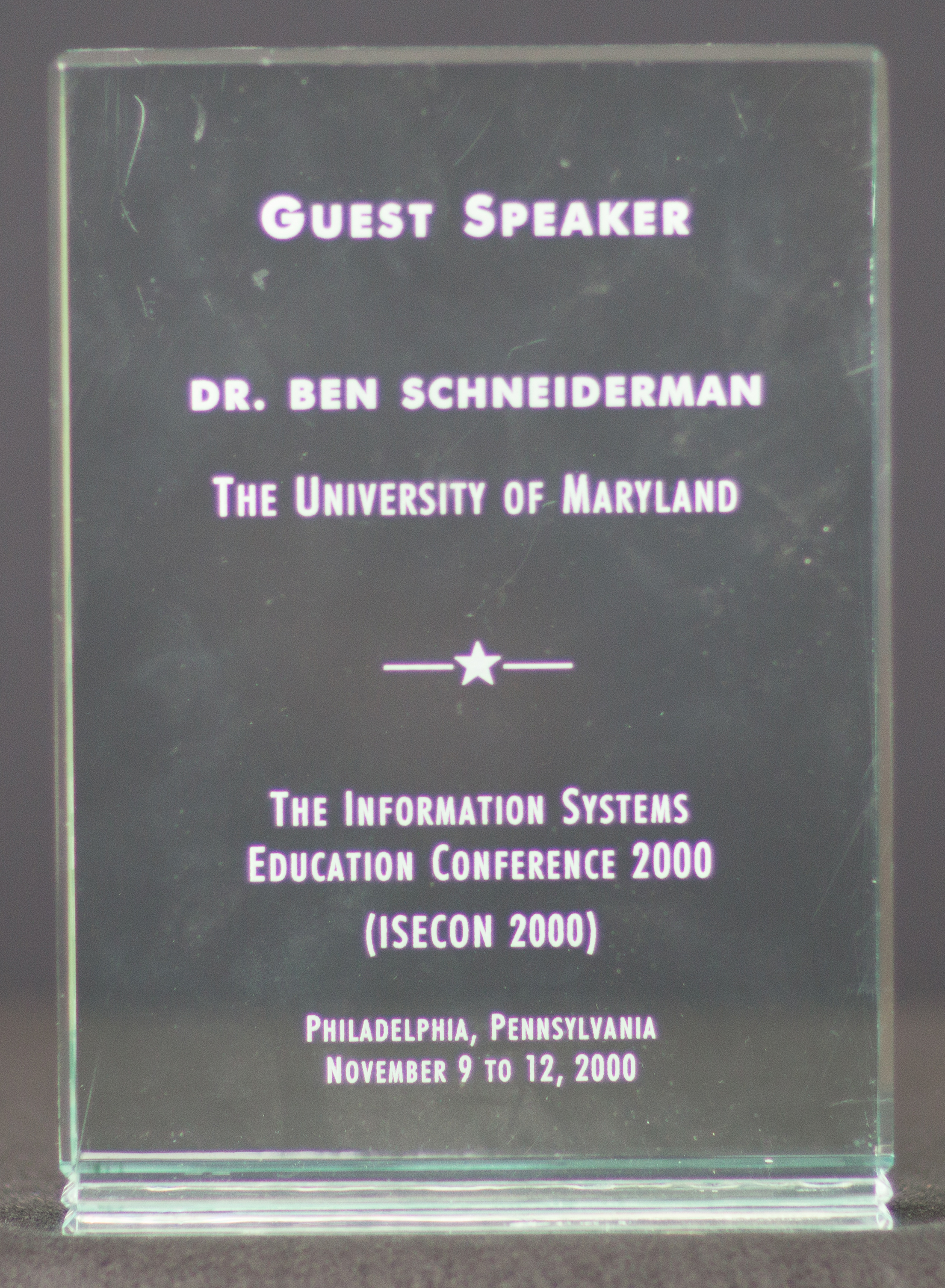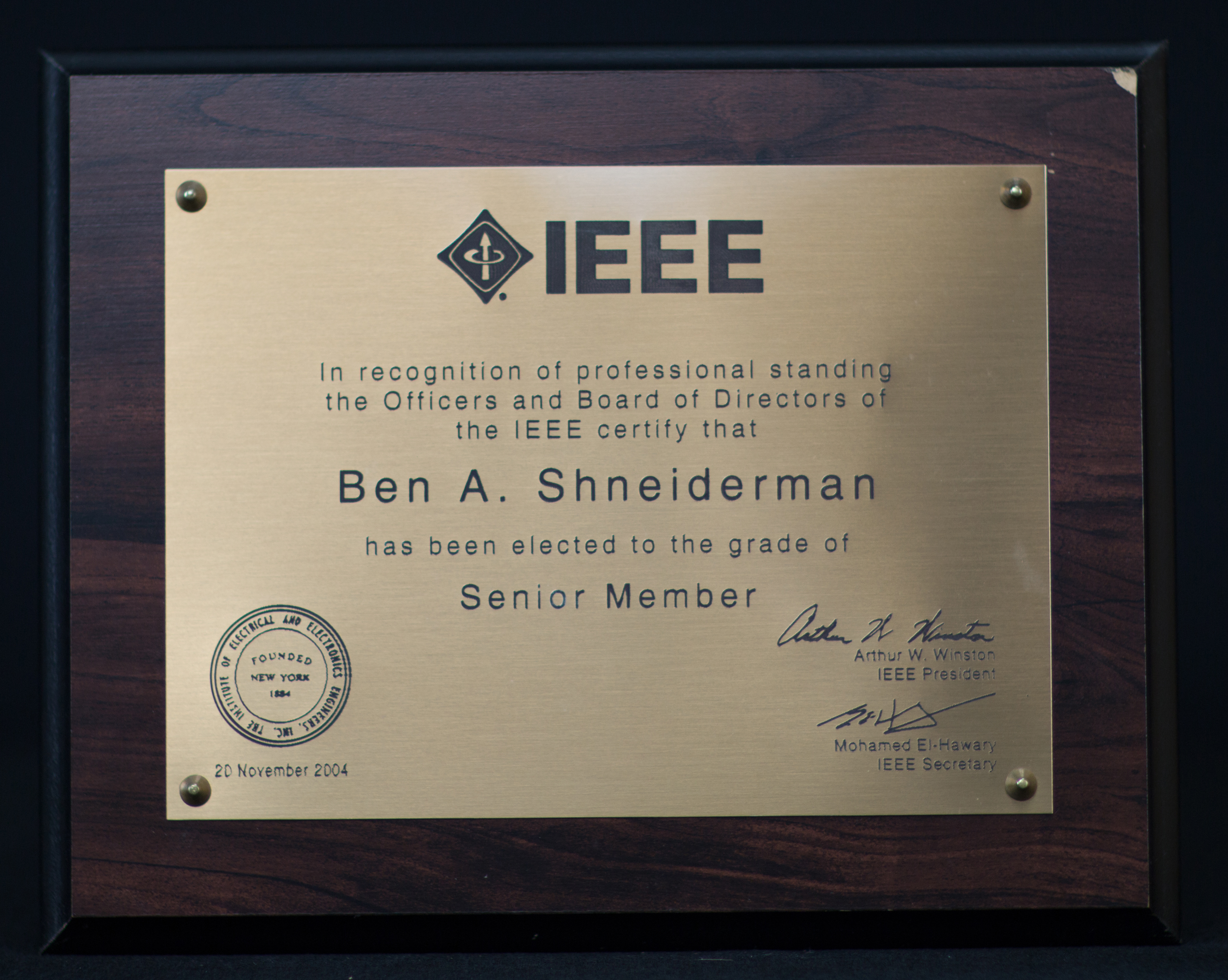On the Occasion of Ben Shneiderman's Retirement
Ben Shneiderman's Retirement
A Retrospective
Career Profile of Ben Shneiderman
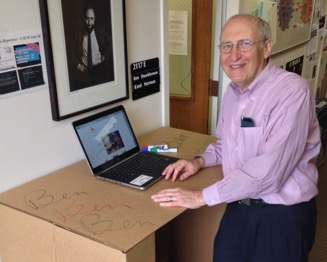 Ben Shneiderman’s work has had a huge impact, far beyond what most academics can expect to achieve. According to Google Scholar his 74,000+ citations make him the most cited University of Maryland College Park faculty member.
Ben Shneiderman’s work has had a huge impact, far beyond what most academics can expect to achieve. According to Google Scholar his 74,000+ citations make him the most cited University of Maryland College Park faculty member.
Ben Shneiderman is a member of the National Academy of Engineering, in recognition of his pioneering contributions to human-computer interaction and information visualization. He is also a Fellow of the American Association for the Advancement of Science, the IEEE, the ACM, and the National Academy of Inventors. This astonishingly broad support for him indicates widespread appreciation of his accomplishments. His 40-50 public lectures a year have meant he is known widely to researchers. He has been featured as a TED speaker (1998) and profiled in Scientific American (1999).
His internationally acclaimed books, such as Designing the User Interface, now in 6thEdition (2016), and Leonardo’s Laptop (2003) have earned numerous awards and been translated into eight languages. These influential books secured his position as an inspirational leader in the maturing field of human-computer interaction, whose remarkable products have reshaped the world we live in. Shneiderman himself was a key figure in developing the selectable link of the World Wide Web and the small touchscreen keyboards that are so prevalent in smartphones and other devices. His research and advocacy for universal usability help ensure access by diverse users.
Shneiderman’s research on information visualization enables exploration of complex data that describe key phenomena, such as business information, social networks, electronic health records, etc. He developed widely used and commercially successful visualization tools such as Spotfire and the open source successes of treemaps for hierarchical data and NodeXL for network data. His work on event analytics continues to gain popularity in finding actionable patterns in medical histories, customer shopping reports, or cybersecurity logs.
Ben Shneiderman’s primary collaborator for the past 30 years has been with Research Scientist Catherine Plaisant, whose complementary skills make them a highly creative and productive team. Shneiderman’s close collaboration with students has helped him achieve breakthroughs, leading students to successfully recommend him to be campus Mentor of the Year (2012).
His latest ambitious effort is to transform academic research so that it has greater societal impact. His book The New ABCs of Research: Achieving Breakthrough Collaborations (2016) lays out a visionary plan for achieving the twin-win of excellence in applied & basic research so as to produce practical solutions that are disseminated widely and high-impact peer reviewed papers that present validated theories.
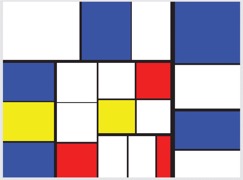 In addition to these research accomplishments and technology innovations, Shneiderman’s broad vision is demonstrated in the aesthetically attractive and informative art works based on real data. His Treemap Art Project (http://treemapart.wordpress.com) produced 12 large colorful prints which have been on exhibit at the University of Maryland, the National Academies in Washington, DC, the Howard Hughes Medical Institute, and University of California at Irvine. A set of the 12 prints is in the collection of the Museum of Modern Art in New York City.
In addition to these research accomplishments and technology innovations, Shneiderman’s broad vision is demonstrated in the aesthetically attractive and informative art works based on real data. His Treemap Art Project (http://treemapart.wordpress.com) produced 12 large colorful prints which have been on exhibit at the University of Maryland, the National Academies in Washington, DC, the Howard Hughes Medical Institute, and University of California at Irvine. A set of the 12 prints is in the collection of the Museum of Modern Art in New York City.
A Pioneer in Human-Computer Interaction
Ben Shneiderman, a Distinguished University Professor of computer science, discusses his contributions to the field of human-computer interaction. Shneiderman credits much of his productivity and impact to his students, and to more than 25 years of collaboration with UMIACS Senior Research Scientist Catherine Plaisant, also featured in the video.
Incubators for Excellence: Department of Computer Science and UMIACS, University of Maryland
Having spent 41 years as a professor at the University of Maryland, I deeply appreciate how it enabled me to pursue my professional goals in developing the fields of human-computer interaction and information visualization within the rigorous Department of Computer Science. The University of Maryland gave me a diverse community of excellent colleagues within computer science and beyond. It brought me skilled technical and administrative staff who facilitated my work and excellent graduate and undergraduate students who inspired me to do my best. All of them have made my time here satisfying and memorable.
Everyday there were interesting speakers on campus and opportunities to connect with colleagues at nearby institutions or to bring scholars to our campus for collaborations, talks, and workshops. The diverse opportunities in working with federal agencies, corporate partners, and non-government organizations enriched our research by allowing us to form partnerships with practitioners and the ability to test theories while working closely with them. The University of Maryland’s location meant that major conferences were often just a metro ride away or that visitors could easily come to us. Flying out to give talks was often just a day trip.
Warren Bennis’s book on Organizing Genius describes innovative communities such as Apple, the Manhattan Project and the Lockheed Skunk Works. In a similar way, the Department of Computer Science (CS) and the University of Maryland Institute for Advanced Computer Studies (UMIACS) became incubators of excellence by enabling faculty to form new disciplines and pursue breakthrough research projects. Launched in the early days of the computer age, CS (founded in1974, https://www.cs.umd.edu/) and UMIACS (founded in1986, https://www.umiacs.umd.edu/) faculty and students produced more than their share of brilliant leaders and creative researchers, whose work continues to influence the information age.
Remarkable Colleagues
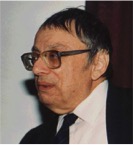 The stories of excellence began with numerical analyst Werner Rheinboldt who was the first computer scientist on campus. I never met him, but I was the beneficiary of his hiring the legendary Azriel Rosenfeld (1931-2004), who was a key figure in starting the field of computer vision. His intense work ethic and capacity to turn ideas into mathematical clarity, inspired a generation of students – especially the 51 PhD students he advised. Rosenfeld’s book on Digital Picture Processing (1976) became the source book for work that continues today. He appreciated my view that user interfaces were a powerful topic and early in my career (1983) gave me the opportunity to start the Human-Computer Interaction Lab (HCIL) as part of his Center for Automation Research (CfAR). Eventually HCIL became a lab within UMIACS and gained a world-wide reputation.
The stories of excellence began with numerical analyst Werner Rheinboldt who was the first computer scientist on campus. I never met him, but I was the beneficiary of his hiring the legendary Azriel Rosenfeld (1931-2004), who was a key figure in starting the field of computer vision. His intense work ethic and capacity to turn ideas into mathematical clarity, inspired a generation of students – especially the 51 PhD students he advised. Rosenfeld’s book on Digital Picture Processing (1976) became the source book for work that continues today. He appreciated my view that user interfaces were a powerful topic and early in my career (1983) gave me the opportunity to start the Human-Computer Interaction Lab (HCIL) as part of his Center for Automation Research (CfAR). Eventually HCIL became a lab within UMIACS and gained a world-wide reputation.
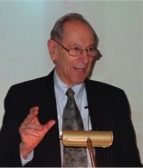 While the world-famous father of computing education, William Atchison served as the initial temporary chair of computer science, Jack Minker became the first permanent department chair (1974). He established a solid administrative foundation, while also developing the key research field of database logic that propelled database systems and artificial intelligence research. In addition, Minker’s courageous leadership for ACM’s Committee on Scientific Freedom and Human Rights (1980-1989) shows how one faculty member can stimulate world-wide efforts to promote noble causes – it was an inspiring example that has encouraged my own activism. He tells his story in the book: Scientific Freedom & Human Rights: Scientists of Conscience During the Cold War (2012).
While the world-famous father of computing education, William Atchison served as the initial temporary chair of computer science, Jack Minker became the first permanent department chair (1974). He established a solid administrative foundation, while also developing the key research field of database logic that propelled database systems and artificial intelligence research. In addition, Minker’s courageous leadership for ACM’s Committee on Scientific Freedom and Human Rights (1980-1989) shows how one faculty member can stimulate world-wide efforts to promote noble causes – it was an inspiring example that has encouraged my own activism. He tells his story in the book: Scientific Freedom & Human Rights: Scientists of Conscience During the Cold War (2012).

 The synergistic enthusiasm of Victor Basili and the thoughtful skepticism of Marv Zelkowitz made the Department of Computer Science a world leader in making software engineering a respected component of computer science. Basili’s Experience Factory concept is the predecessor for continuous quality improvement and evidence-based learning systems, which have become widely implemented strategies. Similarly, his “Goals, Questions, Metrics” approach to dealing with complex systems of human endeavors has shaped contemporary thinking in many management situations. This work, combined with Zelkowitz’s beliefs in empirical validation of software engineering methods, pushed NASA-Goddard and hundreds of other organizations to improve software quality in measurable ways.
The synergistic enthusiasm of Victor Basili and the thoughtful skepticism of Marv Zelkowitz made the Department of Computer Science a world leader in making software engineering a respected component of computer science. Basili’s Experience Factory concept is the predecessor for continuous quality improvement and evidence-based learning systems, which have become widely implemented strategies. Similarly, his “Goals, Questions, Metrics” approach to dealing with complex systems of human endeavors has shaped contemporary thinking in many management situations. This work, combined with Zelkowitz’s beliefs in empirical validation of software engineering methods, pushed NASA-Goddard and hundreds of other organizations to improve software quality in measurable ways.
Hanan Samet’s lucid analyses and creative innovations in algorithms for spatial data structures are used by billions of people, whenever they open a mapping application on their mobile devices. Samet’s extraordinary books The Design and Analysis of Spatial Data Structures (1990) and Foundations of Multidimensional and Metric Data Structures (2006) are vital contributions that have made academic research and commercial application in many areas of computer science possible. It was natural that when ACM started the Transactions on Spatial Algorithms and Systems, that Samet would be appointed editor-in-chief.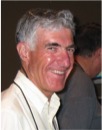
Many more stories bolstered the Department’s reputation for academic rigor and innovative leadership. The field of scientific computing was substantially advanced by the highly mathematical and diligent work of Pete Stewart, Dianne O’Leary, and Howard Elman. Department Chair John Gannon’s devotion to the field was apparent in the many hours he spent working with individual students in his office, right up to his untimely death at age 51.
Bonnie Dorr presented a very different personality style by energetically promoting natural language processing as a research topic within the department, as President of the Association for Computational Linguistics, and as a DARPA program manager. The kind and wise Ashok Agrawala’s broad interests in networks, operating systems, and information technologies has continually influenced graduate students and industry work. Fast-talking Bill Gasarch has led the way on theoretical computer science and championed the topic in his widely popular co-authored blog on Computational Complexity.
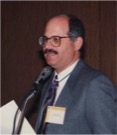 As Department Chair for more than 10 years, Larry Davis kept us functioning smoothly, while being amazingly productive with his research time. His focus on computer vision research and prolific production of PhD students, is clearly inspired by his mentor, none other than Azriel Rosenfeld. I particularly appreciated that Larry Davis led the effort to nominate me to become an IEEE Fellow.
As Department Chair for more than 10 years, Larry Davis kept us functioning smoothly, while being amazingly productive with his research time. His focus on computer vision research and prolific production of PhD students, is clearly inspired by his mentor, none other than Azriel Rosenfeld. I particularly appreciated that Larry Davis led the effort to nominate me to become an IEEE Fellow.
UMIACS Directors have also played important leadership roles in promoting a productive intellectual community. Larry Davis, Joseph JaJa, VS Subrahmanian, Amitabh Varshney, and now Mihai Pop all gave generously of their time by providing and managing resources that enabled us to do our work. Another important and memorable aspect of the CS & UMIACS experience has been the hard-working, competent, and diligent staff who helped the faculty and students every day in meaningful ways.
Indicators of Excellence
Some faculty have gone on from UMD to make further contributions elsewhere. This includes Mark Weiser who became the Head of the Computer Science Laboratory at the famed Xerox PARC. His 1991 Scientific American article on “The computer for the 21st century” is among the most influential in computing. Former Department Chair Satish Tripathi has gone on to become SUNY-Buffalo’s president. Other former faculty members are department chairs and leading researchers at major universities.
The Department is also famous for its students, especially the more than 800 PhDs who have become industry leaders, prominent government lab researchers, academic stars, and successful entrepreneurs. For example, Glenn Ricart is a national technology leader, honored in the Internet Hall of Fame, while many other alumni continue to collect awards and recognitions from professional societies such as IEEE, ACM, AAAS, AAAI, and ACL.
Even our undergraduates had outstanding successes, including Sergey Brin, whose father Michael was a math professor at UMD. Like many immigrant children Sergey Brin came to study here, earned his BS degree (1993), and then went on to co-found Google. Other alumni have established companies and lead research groups around the world. A recent success story includes three of the founders of Oculus VR, which was purchased by Facebook for $2B (2014), enabling the founders to donate funds for the construction of the Brendan Iribe Center for Computer Science and Engineering, which is scheduled for completion in 2019.
There are many other stories of remarkable faculty making breakthroughs and astonishing students winning prizes. One of our advantages was Jack Minker’s influential effort in mentoring several dozen young faculty in their applications for the Presidential Young Investigator and NSF Career Awards, thereby accelerating their research agendas. Another departmental asset was work by faculty a few years younger than me who introduced our community to emerging topics.
Collaborations
One measure of the impact my colleagues have had on me is the number of co-authored papers I have written with them. The list of CS Faculty co-authors includes Vic Basili, Ben Bederson, Amol Deshpande, Bonnie Dorr, Ramani Duraiswami, Christos Faloutsos, Richard Furuta, Lise Getoor, Steven Salzberg, Neil Spring, and Mark Weiser. Other collaborations with faculty in the Colleges of Information Studies (especially Gary Marchionini), Engineering, Behavioral and Social Sciences (especially Kent Norman), Business, and Computing, Mathematics and Natural Sciences, as well as off-campus partners also enriched the experience, improved the work, and raised the impact.
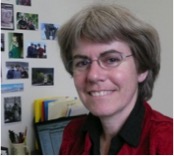 My main collaborator for the past 30 years has been UMIACS Research Scientist Catherine Plaisant, who has been a reliable partner in supervising students and writing more than 90 joint papers. Her devotion to working closely with our practitioner partners, her creative approaches to problems, and her diligence in evaluation raised the quality of our joint work – and made for satisfying professional and personal experiences. I also appreciated those supportive faculty members, especially Ben Bederson and Jon Froehlich, who over the years participated in work on the emerging topics of human-computer interaction and information visualization.
My main collaborator for the past 30 years has been UMIACS Research Scientist Catherine Plaisant, who has been a reliable partner in supervising students and writing more than 90 joint papers. Her devotion to working closely with our practitioner partners, her creative approaches to problems, and her diligence in evaluation raised the quality of our joint work – and made for satisfying professional and personal experiences. I also appreciated those supportive faculty members, especially Ben Bederson and Jon Froehlich, who over the years participated in work on the emerging topics of human-computer interaction and information visualization.
The deep collaborations with wonderful undergraduate and graduate students gave meaning to my career, inspiration to push forward, and hope for the future. The new Iribe Center for Computer Science and Innovation, which became possible because of the hard work of Department Chair Samir Khuller, Emeritus Professor Bill Pugh, and others, will be a welcoming home for our students and a place where faculty and staff can continue our traditions of quality.
Conclusion
In summary, this rich environment of star performers pushed me along to make my own contributions. Each colleague has been an inspiration, as they pursed their own research agendas, offering their distinctive style and giving me examples of visionary goals. I thank them and celebrate their contributions (see the histories written by Jack Minker and Marv Zelkowitz https://www.cs.umd.edu/about/history). As I move on to research policy projects, more time with family and friends, and new adventures with my wife Jenny, I have high confidence that the Department of Computer Science and UMIACS will remain incubators of excellence.
2013 Graduate Mentor Nomination
In 2013, Ben Shneiderman received UMD's Graduate Faculty Mentor of the Year Award. Below, is the text of the nomination letter submitted by Ben's current and former students.
March 25, 2013
2013 Graduate Faculty Mentor of the Year Award Selection Committee
c/o Dr. Mark Leone or Ms. Robyn Kotzker
The Graduate School, The University of Maryland, College Park
To the Award Selection Committee:
We are writing to nominate our doctoral advisor Dr. Ben Shneiderman, Professor of Computer Science, for the 2013 Graduate Faculty Mentor of the Year Award. Ben founded UMD’s Human-Computer Interaction Lab (HCIL) 30 years ago, and he has since advised 17 students to completed PhDs and will be graduating three more this year. His continuous efforts to guide our work and advocate for us have been fundamental to our success, as we detail herein.
The advisor-student relationship is very much like an apprenticeship of old. The master teaches his craft; and the students learn, absorb, and practice. In the setting of an university, the master teaches science in a specific field and helps students navigate the degree process. However, after learning from and working with Ben we came away with much more. Ben is a scholar, and he prepares his students to be scholars. Not only do students need to fulfill graduation requirements, but Ben also makes sure students are exposed to the different parts of academic life: meeting visiting researchers, planning and running workshops, presenting our work to the public, doing summer internships, guiding newer students, etc... This exposure helps us decide whether we would fit well in an academic career.
Setting goals: Ben is always thinking about the big picture of the dissertation, but the refrain you always hear when working with him is “something small soon”. Instead of setting large, amorphous, and hard to meet goals, at each meeting he wants to know what the next small step is and when it will be done. This approach is highly effective for the design projects we work on at the HCIL, but also helps students finish writing articles and dissertations. Ben strikes a balance between focusing on these small steps and keeping the overall plan in mind. If lost in the details of a project, Ben will discuss them with you and help you focus your energy on the components that are truly necessary for novel research. Moreover, for dissertation proposals he asks his students for a specific plan of attack for each coming semester: what tools will be built, evaluations conducted, and papers written. In Sureyya’s experience, Ben taught her the importance of setting high standards and helped put structure to her ideas.
Communication: Ben is a great communicator, both in scientific discourse and in person. He is always happy to listen to our ideas (whether good or half-baked) and to offer his evaluation. He welcomes differences in opinion and encourages thinking outside of the box. Because Ben listens and take his students’ best interests to heart, he can find the most effective way to mentor each student. He is keenly aware of each students’ differences and so he works with each of us and communicates with each of us a little differently to motivate, encourage, and guide us in our graduate years. Not every mentor is as flexible, and not all mentors are as willing to be flexible. Those of us that need plenty of contact generally meet with Ben every week, or even several times a week in crunch periods. In addition, he seems to be always available, even when on vacation. When Cody ran a last-minute user study the weekend before a paper deadline, he called Ben for help – reaching Ben on his cell phone at 7pm Friday night. Similarly, when a time-critical grant arose to send students to a premier conference Ben called Cody and Krist to ensure the opportunity did not slip away. Even when Ben works from home, he often invites students over to collaborate and have lunch. And when the weather is nice, he takes students on walks to nearby Lake Artemesia, individually or as groups. When all these discussions weren’t enough to get a student writing, Ben would sit with them and engage in collaborative stream-of-consciousness writing to help get it done.
Innovative research: When recruiting a student to work on a project, the first thing on Ben’s mind is “how will this help the student finish their PhD?” He involves students in each step of the research process, helping them set their own goals and directions and guiding them through the design, development, evaluation, publication, and outreach involved in each project. It is easy to get trapped in the research world and forget how to make your research useful and practical. One way Ben encourages innovative research is to have students to work with users or mentors in other fields, both to provide practical problems with real impact and to evaluate the effectiveness of the students’ approaches. Convincing yourself that your idea is good is not hard. Convincing your advisor is harder. But convincing other people that your idea can improve their work, speed up their workflow, or open up a new way of thinking about their problems is not easy at all. When we talk about our work, we are proud to tell people not only about the ideas, but the fact that we have convinced users that it works and proved that it is really useful. This collaboration results in applications in areas as diverse as sociology, urban planning, biology, medicine, law, scientometrics, finance, etc. These studies are pivotal parts of our dissertations, but Ben is always looking for further applications of our work, especially if it has commercial implications. He was part of the entrepreneurial process of Spotfire and served on its board, and now, understanding how the commercial world works, he encourages us to work with companies to advocate our research. These collaborations couldn’t have happened without Ben’s guidance.
Professional development: Ben is always advocating for his students to help them make connections with other scientists, spread their research, and land interesting internships and jobs. One of his biggest strengths is his ability of representing the University, the Department and the HCIL in the many talks he gives all over the world. More than just spreading the word about the great work that we do in the lab, he constantly showcases the projects developed by his students and names them in his presentations, even many years after graduation. It is an honor to be in his presentations, and it is common when meeting a colleague for the first time that they have already seen one of Ben’s presentations and thus, your work. Krist was amazed how many people at Twitter, where he now works, have seen Ben’s talks. Recently Krist had lunch with a guy who talked about Ben and his presentation about Lifelines. Krist smiled the whole time, eventually revealing that Ben was his advisor.
Another way Ben increases our visibility is by encouraging us to give frequent talks and tu- torials to varied audiences. He spends his personal money to help students attend academic conferences to present their papers, such as $250 for Cody to attend SIGCHI and another $622 for Graph Drawing. Ben also donated $6500 to establish the HCIL Conference Travel Award, and then recruited his academic and industry colleagues as other founding contrib- utors. The award has already paid $3000 for three students to attend SIGCHI 2013. In addition to monetary support, Ben encourages publication and outreach. Students in his graduate Information Visualization course are asked for their course projects to tackle novel problems and to publish their results, with about two accepted papers per year. Moreover, Ben lets students be his stand-in when he can’t make an appearance and suggests us in his place. Sureyya and Megan visited Wales for a week because Ben couldn’t make the trip – a pretty killer perk of being one of his students. In one case, Ben even shared part of a keynote speech with Cody! Ben obviously trusts his students to represent him and the lab abroad.
Ben is also very social and happily shares his contacts. Because he meets so many people and is renowned, he knows who to talk to when you are looking for collaborators or jobs. He will ask friends in an area to see if they’ll have you come in and give a guest lecture (both to promote your work, and to let them know you are on the job market). We, as Ben’s students, effectively inherit his contacts. Dave and Cody had several opportunities to give talks from these kinds of connections, which was a huge boost for their careers. Ben has helped countless students attain internships and interesting careers though his dedicated work writing reference letters. Ben is extremely kind and thoughtful when writing reference letters, and always seems to be the first to upload his letter and the first to reach out on your behalf. In John’s job
search, his interviewers shared with him the enthusiasm that Ben put in his letter – describing anecdotes that showcased his skills and greatly influencing the interviewers’ opinions. When John and Sureyya interviewed at PARC for different positions, the interviewer was amazed to see how much of their styles had been influenced by Ben’s advice. The interviewer found they excelled at group cooperation, expressed their thoughts in a respectful, organized, positive and assertive way, and were always looking for improvements. Ben guides us to be this way, which pays dividends later in the job search process. With Ben’s help we have landed work at giants like IBM, Microsoft, Xerox PARC, Twitter, Amazon, Ebay, and Northwestern.
Encouragement: Every time you meet with Ben he asks about your life, family, and how things are going. He truly cares about students as individuals and remembers the details of their lives and their ambitions. This results in frequent reminders about work-life balance and the importance of exercise. When discussing research, Ben is always positive, constructive, and excited to see progress. In addition to supporting our successes, Ben stands by us when we fail and never lays blame or abandons us. When Krist’s papers were rejected, Ben always said it is also his responsibility that he did not help as much as he should and that they should try again. Ben then helped with necessary revisions and any change of focus or venue. Many international students have difficulties acclimating to the environment of a U.S. university. It is important for them to feel welcomed in a group and to understand the culture of the local academic environment, and Awalin found that Ben helped her navigate these dynamics. Ben always asked her to speak up – a very different experience than she was used to in Bangladesh. Moreover, Ben helped her develop techniques for optimistic and constructive criticism.
Conclusion: Ben is a truly amazing graduate mentor, helping us navigate the complexities of a research career and shaping us into valuable members of the scientific community. Ben is a great professor with creativity, depth and breadth of knowledge, and vision; and his enthusiasm and encouragement constantly inspires the people around him. Ben helps us set iterative goals while keeping the big picture in mind, is always available to talk, encourages collaboration with domain experts to develop innovative dissertation topics, and keeps the dissertation in mind as the main goal for every project. He constantly dedicates his time, money, and connections to ensure we have opportunities to do interesting research and present the results. Ben accomplishes all this while paying attention to our individual needs and ambitions. We, his current and former PhD students, believe that his many years of dedicated service to us and the UMD community should be recognized. We heartily endorse Dr. Ben Shneiderman as our nomination for the 2013 Graduate Faculty Mentor of the Year Award.
Thank you for your time and consideration.
Sincerely,
Graduating PhD students: Cody Dunne (contact), John Gomez, Sureyya Tarkan Current PhD students: Megan Monroe, Awalin Sopan, Rongjian Lan, Hanseung Lee Recent PhD Alumni: Krist Wongsuphasawat ’12, David Wang ’10, Adam Perer ’08
Videos
May 1, 2017 Reception
To Ben Shneiderman, on his retirement
Selected Photos
During the May 1 reception, Ben displayed a selection of photos from his extensive collection. Faculty, colleagues, and students he has known through the years are depicted. Enjoy them as two downloadable PDF's.
